Domus Aurea Rome (Nero's Palace)
Tours and tickets for visiting nero's golden house in rome.

Domus Aurea is the 'Golden House' of Emperor Nero in Rome. After a major fire in 64 AD. Nero built this impressive palace complex, which you can now visit with a tour.

Nero’s Golden House
After a major fire in Rome in 64 AD, Emperor Nero had the huge palace complex Domus Aurea (" Golden House ") built in Rome. There are even rumors that Nero would have started this fire himself to create space for his palace. The 80-hectare complex with more than 150 rooms was the most striking and most expensive palace in Rome , with lots of marble, ivory and gold leaf walls. From the Roman Forum , the palace had an impressive entrance with a colonnade and a 35-meter-high statue of Nero himself at the time.
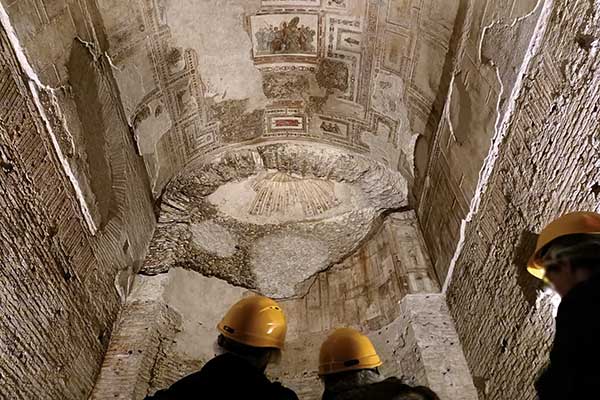
Nero committed suicide in A.D. 68, so he never had the chance to experience the completion of the palace. His later successor Otho took care of the further completion. Since emperor Nero was not particularly loved by the people, later emperors Domus Aurea partly demolished again to erase the memories of Nero and built other buildings on top, such as the Baths of Trajan. The gardens were surrounded by large gardens and a landscaped lake; the Colosseum was later built in this lake.
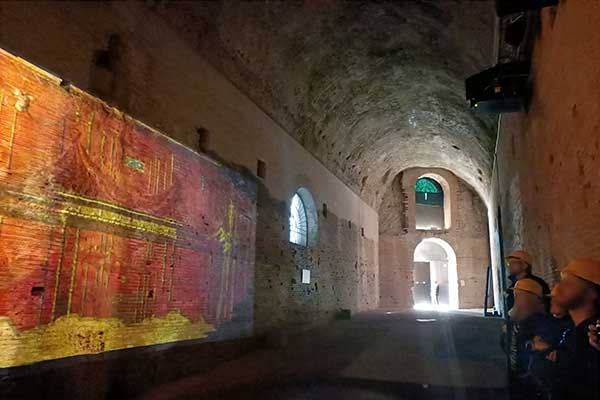
Around the 15th century, old works of art were again searched, including the well-known Laocoön group that can now be found in the Vatican museums . Domus Aurea could not be visited for years due to security, but since 2014 part of the rooms and frescoes can be seen again.
Visit Domus Aurea?
Visiting Domus Aurea is only possible in small groups with a guide. There is sometimes even a tour where you get to see what the palace of Nero with VR glasses. Tours are only possible during the weekend, because during the week a lot of work is being done on the restoration of Domus Aurea. Online reservations of Domus Aurea tickets are required and can be done via this website .
Book your visit
Video: Domus Aurea
Where is domus aurea in rome.

Most visited attractions

Top 25 Things to do in Rome

Colosseum & Tickets

Sistine Chapel & Vatican Museums

St.Peter's Basilica & Tickets

+39 055 5321180
print your voucher

- Rome Attractions
- Domus Aurea Guided Tour
Nero's Domus Aurea, Guided Tour in English
An extraordinary experience to explore the sumptuous home built at the behest of Emperor Nero a short way from the Colosseum ! This special guided tour is the only way to visit what remains of the Domus Aurea and learn about its history led by an official guide.
about 75 minutes
The ticket includes booking to skip the line at the entrance.
The route is partially wheelchair accessible. Not suggested for visitors with motor disabilities.
Weekend. Multiple tour start times are available at the visitor's choice.
We recommend wearing comfortable shoes and windbreakers. Underground path with high humidity and rough terrain.
Description of your booking
This booking lets you tour Domus Aurea an official in-house guide. The tour includes a guided tour in English on foot where the majestic residence of the emperor Nero had been built. Because it is a guided tour for up to 46 people, the archaeological site of the Domus Aurea can only be accessed by the public by booking this guided tour. Once the mandatory protective helmet is on, visitors enter the imperial residence to see the frescoed rooms which recent restoration have brought back to light. Because this archaeological area is still under restoration, the tour is aided by the use of 3D viewers. Visitors can sit and watch a film for about 20 minutes that recreates the appearance of how the residence looked at the peak of its glory. The viewers faithfully recreate the majesty of the Roman emperor's palace in ancient times.
What is included
- One admission to the Domus Aurea - Guided tour - Helmet - 3D viewer for multimedia visits (about 20 minutes) - Paper digital guide of the archaelogical site in English and map
What is not included
- Admission to other sites
The tour's start time and other useful information which will be printed on the confirmation voucher. As there is high demand and limited ticket availability, the time and date of this reservation may be changed. Our staff will contact you if that should happen to suggest alternatives. We will use the contact details you provided when you booked. PLEASE NOTE!!! There are very limited places for this tour. Sending an order and receiving a copy of your order by email is not a BOOKING CONFIRMATION; it is just a booking request. The booking will be confirmed only when you receive the VOUCHER. If the time and date are not available, we will contact you promptly to suggest alternatives or refund your payment if already made.
Price for this package includes entrance ticket with guided tour and a digital guide in pdf format of the archaelogical site with map.
European Citizens 18-24 years old. Price for this package includes entrance ticket with guided tour and a digital guide in pdf format of the archaelogical site with map.
Children 0-17 years old. Price for this package includes entrance ticket (0.00 euros), guided tour and a digital guide in pdf format of the archaelogical site with map.
Temporary exhibition extra charges are added automatically to the on line ticket price. Italy Travels is not responsible for any partial closure of rooms, itinerary changes, cancellations or delays in entry due to force meajure, adverse weather, personnel strikes, or decisions made by the management of the museum or the Superintendency. OFFICIAL TARIFFS OF THE TOUR TICKET Adult - 23,00 euros (from Monday to Thursday 18,00 euros) Reduced - 19,00 euros (from Monday to Thursday 14,00 euros) Under 5 years old: 0,00 euros
Cancellation policy
Entry tickets to the Domus Aurea, once booked, may not be changed in any way or canceled . Visitors who come after the time printed on the voucher or are no-shows will not have access to the site and will receive no refund, even partial. Once booked, these tickets cannot be changed. We, therefore, suggest you pay very close attention during the online booking process when choosing the date, time, and type of tickets.
When you can visit Nero's Domus Aurea
Friday, Saturday and Sunday. Multiple tour start times are available at the visitor's choice. - 10:00 AM - 11:45 AM - 03:45 PM
Where is located the Nero's Domus Aurea
Meeting point with the guide: Viale della Domus Aurea, 20 minutes before the tour starting time written on your voucher.

Useful info
The interior is particularly damp. All visitors will be provided with a special helmet to comply with safety regulations. We recommend wearing comfortable shoes and windbreakers. The route is partially wheelchair accessible. For security reasons, this site may be closed even without notice, on the recommendation of the Superintendent. In this case the price paid will be refunded and no further compensation can be requested for the cancellation of the tour even if communicated on the day of the visit.
Nero's Domus Aurea in Rome
The vestibule of the house was so big it contained a colossal statue 120 feet high, the image of Nero; and it was so extensive that it had three colonnades a mile long. There was a lake too, in fact, a sea, surrounded with buildings as big as cities. Behind it were villas with fields, vineyards and pastures, woods filled with all kinds of wild and domestic animals. In the rest of the house everything was coated with gold and adorned with gems and shells. The dining-rooms had fretted ceilings made of ivory, with panels that turned and shed flowers and perfumes on those below. The main banquet hall was circular and constantly revolved day and night, like the heavens. The baths were supplied with both sea water and sulfurous spa water. When Nero inaugurated the house at the end of the works, he showed himself satisfied, and said 'Finally I begin to live in a house worthy of a man.'" (Suetonius)
The history of the Domus Aurea
In the early years of his reign, Nerone had built the "Domus Transitional" designed to connect its possessions. During the terrible fire of 64 A.D. the palace burned completely and therefore it was necessary to build a new imperial residence, the Domus Aurea. The name comes from the Latin, "house of gold". It took this name because of the extensive gold claddings and the ceiling embellished with semi-precious stones and ivory plates requested by the emperator. The villa extended for about 250 hectares, most of the area was occupied by gardens with pavilions destined to parties. At the center of the gardens which included forests and entire vines, there was a pond in part artificial, in which then arose the Colosseum.
Nerone also commissioned a great big bronze statue of about thirty meters reproducing himself, dressed with the old dress of the Roman sun god, Apollo. The statue was placed at the main entrance of the building, overlooking the Palatine Hill. The statue had been adapted over the years with the heads of the various successors of Nerone, before Adriano decided to demolish it, to build the Flavian Amphitheatre, commonly called Colosseum. The “Domus Aurea” was essentially a villa for the holidays with approximately three hundred rooms and none of them used as sleeping rooms. The halls were finely coated in fine polychrome marble or richly frescoed. On each floor there were pools and in the hallways fountains.. The fine mosaics were mainly employed for covering floors, but then Nerone decided to decorate mosaic ceilings of some rooms anticipating one of the main issues of Christian art. Today visitors can admire only few fragments of these old mosaics. It seems that the architects Severus and Celer, designers of the Domus, had created an innovative and ingenious mechanism to ensure the ceiling movement and rotation like the stars in to the sky. After the Nerone’s death, the palace was stripped of its precious coverings. On the plot of the domus Aurea were built the Baths of Titus, the Temple of Venus in Rome and the Coliseum. In forty years, the Domus Aurea was totally buried under these new constructions. The burial helped the paintings to survive as sand worked as the volcanic ash of Pompeii, protecting them from moisture. Towards the end of the XVth century, a young Roman accidentally fell into a cave. The cave was covered with painted figures. Soon the word spread and the young Roman artists lowered themselves down inside the cave to admire the beautiful ancient frescoes. Today the frescoes are faded, but were studied during the Renaissance artists such as Michelangelo and Raphael. Raphael even took inspiration from the frescoes of the Domus Aurea for the making of the Vatican Loggia. Thanks to the discovery of these paintings, the artistic term "grotesque" was created
The Domus Aurea was the subject of a long restoration, the reopening was scheduled for January 2007, but the great monument continued to suffer from the presence of the traffic of the Capital and to the roots of the trees that infiltrated into the ground, creating further instability. For these reasons the restoration is gone very slowly. On the 30 of March ,2010 collapsed the domus’ entrance vault. This prolonged the long period of closure to the public of the archaeological site, until the year 2015.
what to see in Rome news and useful tips
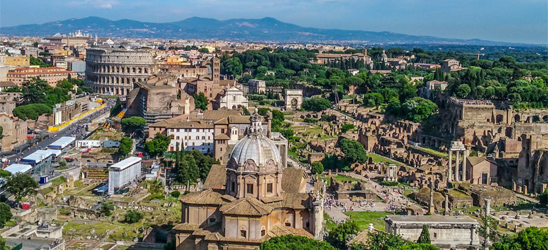
How to visit the Colosseum in Rome
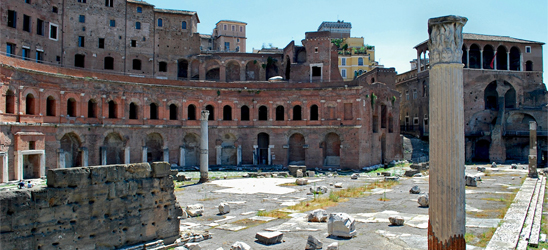
The Trajan’s Markets and Trajan the Roman Emperor
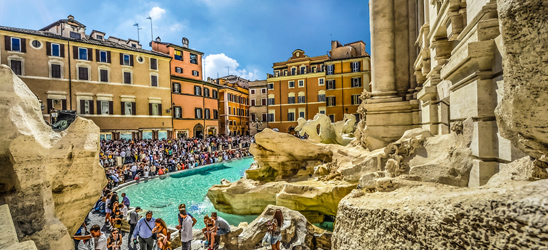
The Trevi Fountain, a must see when in Rome
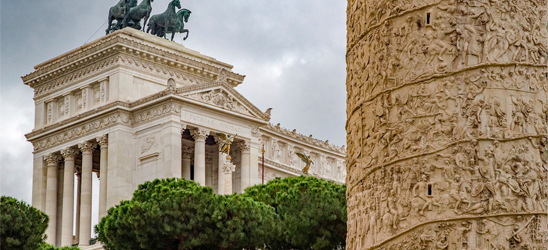
The Column of Trajan in Rome and the Imperial Forums
- Colosseum & Roman Forum
- St. Peter's Basilica
- Vatican Museums & Sistine
Italy Travels Rome
- Legal Information
- Privacy Policy
- Further information on use of cookies
Call our staff for assistance, Monday-Friday, 10:00 am - 5:00 pm.
- Cancellations
- Get your voucher
- Colosseum, Roman Forum and Palatine Hill
- Colosseum with Arena Full Experience
- Colosseum & Roman Forum Private Tour
- Colosseum & Roman Forum Tour
- Forum Pass - Imperial Forums & Roman Forum
- St. Peter's Basilica - Special Fast Track Entrance
- St. Peter's Basilica Guided Tour
- St. Peter's Basilica Private Tour
- St. Peter's Basilica & Castel Sant'Angelo Private Tour
- Vatican Museums Skip-the-line Tickets
- Vatican Tour - Museums & St.Peter's
- Vatican Museums Tickets Night Opening
- Vatican Museums Skip-the-line tickets with audio guide
- Vatican Museums Private Tour
- Vatican Museums & St. Peter Private Tour
- Sistine Chapel Entrance Tickets
- Vatican Gardens Bus Tour
- Pontifical Villas in Castel Gandolfo - Barberini Gardens
- Borghese Gallery Tickets
- Borghese Gallery Private Tour
- Caravaggio in Rome Private Tour
- Baroque Rome walking Tour
- Ara Pacis Museum Tickets
- Castel Sant'Angelo Tickets
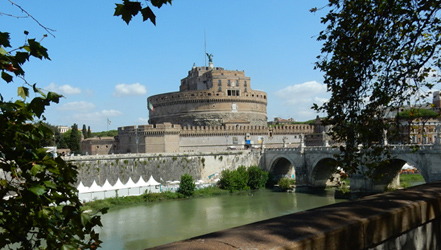
- Trajan's Market Tickets
- Caracalla Baths Tickets
- Palazzo Altemps Museum Tickets
- Palazzo Massimo Museum Tickets
- Hadrian's Villa in Tivoli Tickets
- Capitoline Museum Tickets
- Pantheon with Audio Guide
- Etruscan Museum Villa Giulia
- Private Tour Colosseum and Roman Forum
- Private Tour Vatican Museums
- Private Tour Vatican Museums & St. Peter
- Private Tour Caravaggio in Rome
- Private Tour St. Peter's Basilica Complex
- Vatican Tour St. Peter's Complex & Museums
- Private Tour of Borghese Gallery
- Private walking Tour Baroque Rome
- Colosseum Underground Tour

- Things to Do in Rome
- Where to Stay
- Rome Restaurant Reviews
- Day Trips from Rome
- Shopping in Rome
- Explore Italy
- Life in Italy
- Practical Information
Rome , Things to Do in Rome
Visiting the domus aurea: nero’s golden palace in rome.
There are few figures in Roman history as well known and reviled as Nero. The emperor supposedly played the fiddle while Rome burned. It’s not clear if he really celebrated the destruction of the city in real time, but he certainly took advantage of the fire. After the embers died down, he used the “new” space left empty by the inferno to build his Domus Aurea – Nero’s Golden Palace.
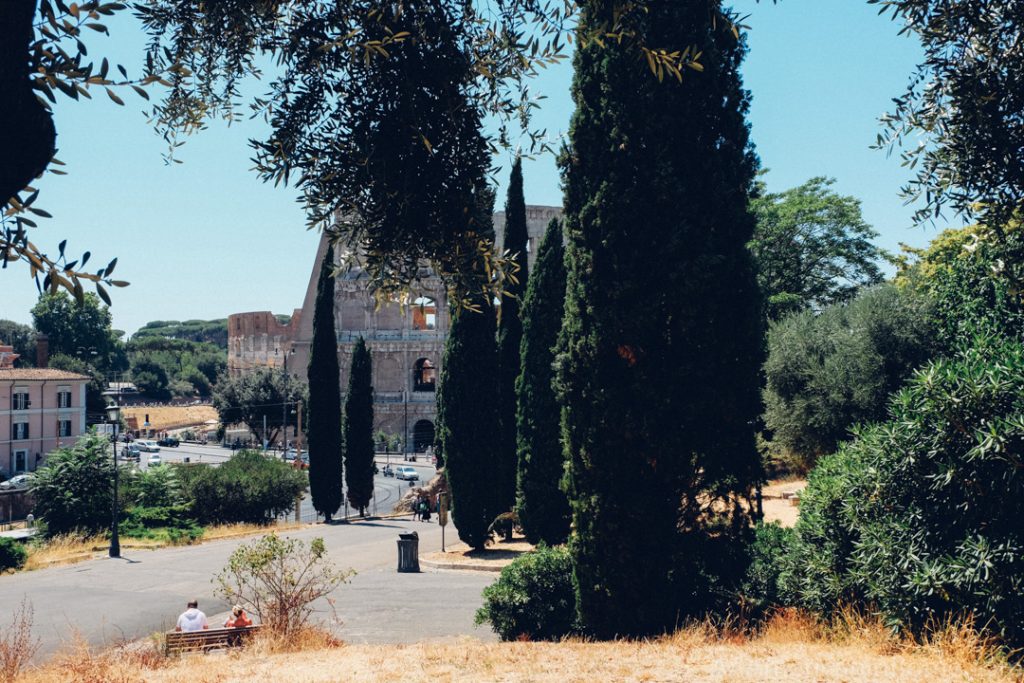
It was probably this lavish display that cemented Nero’s unpopularity. To say that his palace was massive is a bit of an understatement. The Domus Aurea covered somewhere between 100 and 300 acres, reaching from the touching the slopes of the Palatine, Esquiline, Oppian and Caelian hills.
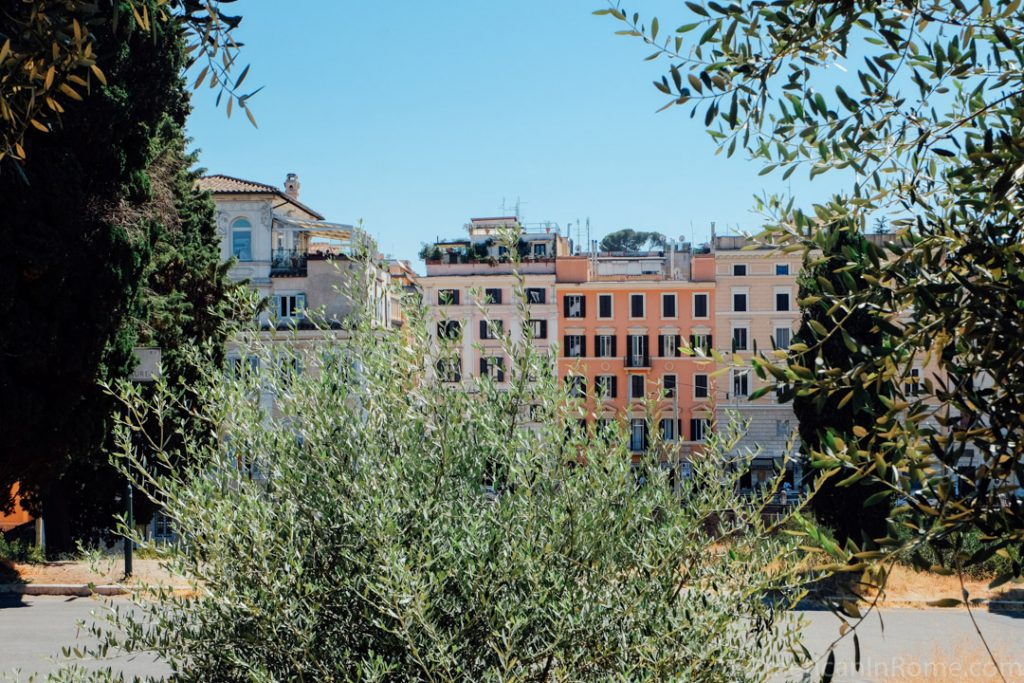
So where is this ginormous palace now?
Most of it lies under Colle Oppio park, looking out at the Colosseum.
Vespasian, the emperor who succeeded Nero, had the palace filled with dirt and destroyed. He then went on to build the Colosseum on top of the artificial lake which Nero had built inside his palace walls.
Buried under Colle Oppio, the Golden Palace was nearly lost – but it is now possible to visit the excavation site.
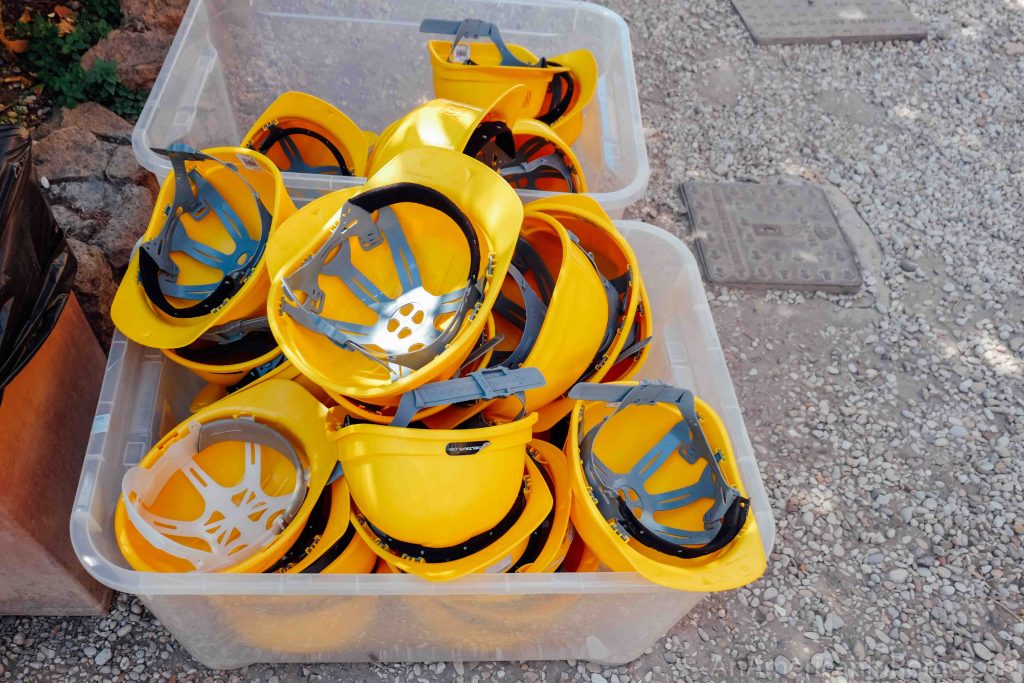
But because there are ongoing excavations taking place, you are going to need a tour (I went with Through Eternity tours ) and a hard hat.
We met with our guide, Brandon, to chat about Nero and learn more about his Golden Palace. Prepped and ready to explore, we grabbed our yellow hats and followed an archaeologist into the site.
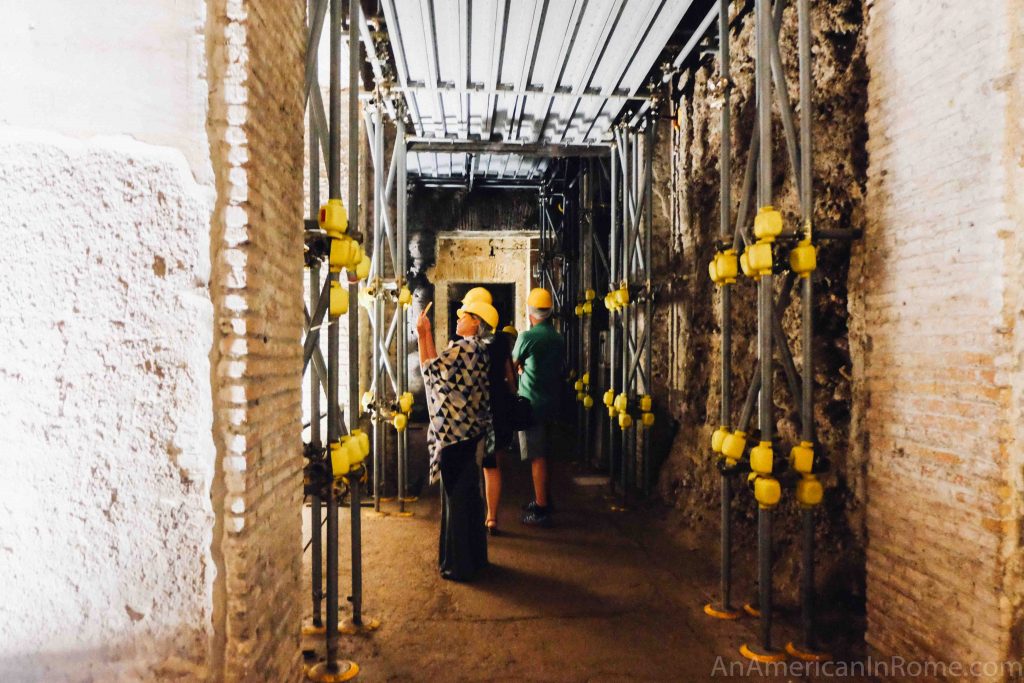
The Domus Aurea is very much an excavation in process. Nero’s Golden Palace was made up of more than 200 rooms, and some have yet to be reopened.
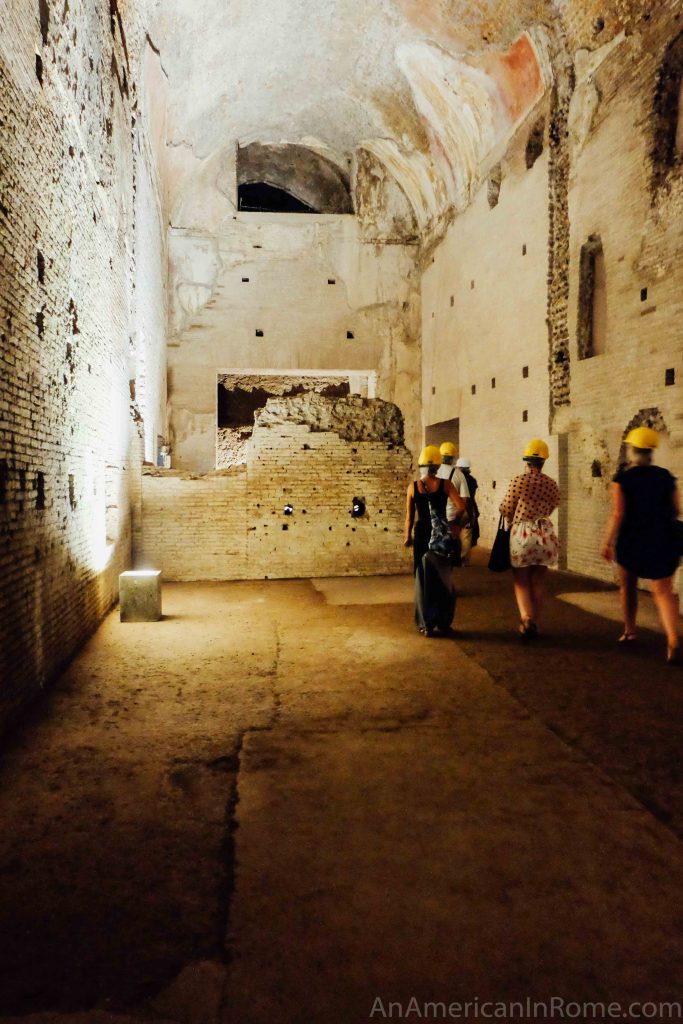
Despite its impressive size, they have yet to find any bedrooms or sleeping quarters – this huge complex was all about entertainment.
In addition to landscaped gardens and a manmade lake, Nero built grottos and dining rooms for his guests to relax in.

He spared no expensive – even decorating the ceilings with mosaics and building an elaborate rotating dome.
Hard to imagine, right?
Which is why part of the reason I loved this visit so much was because:
- I had no idea that the Domus Aurea was right there under the hill.
- There is a virtual reality experience that helps to animate what the Golden Palace would have looked like
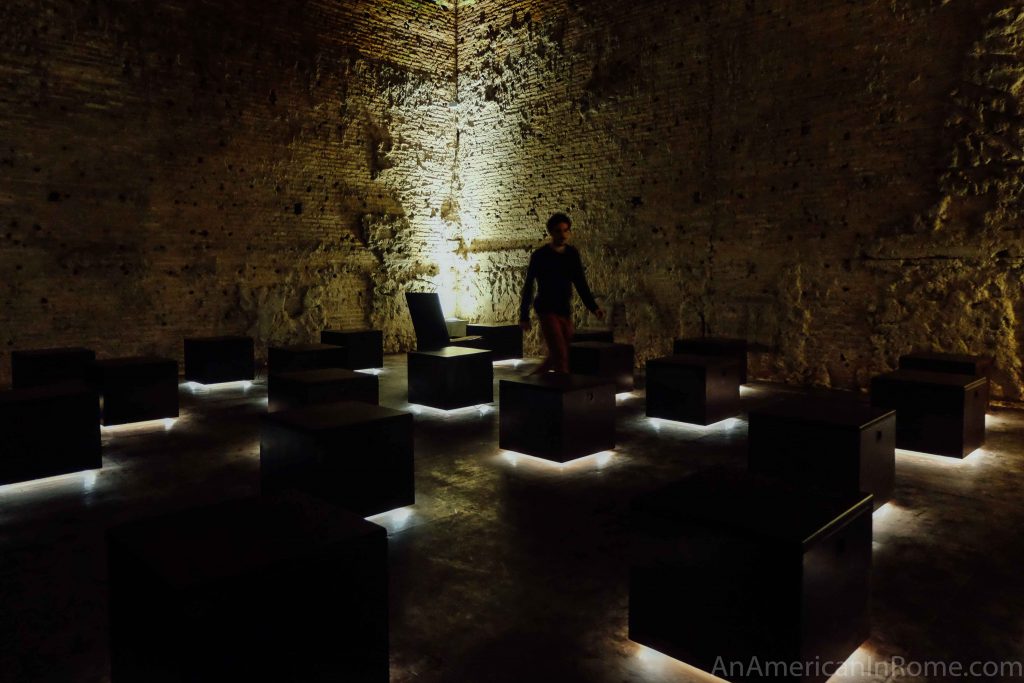
I like Ancient Roman history, but I find it really hard to picture what everything looked like based on the ruins. Having this virtual reality stop was incredibly helpful (and a lot of fun).
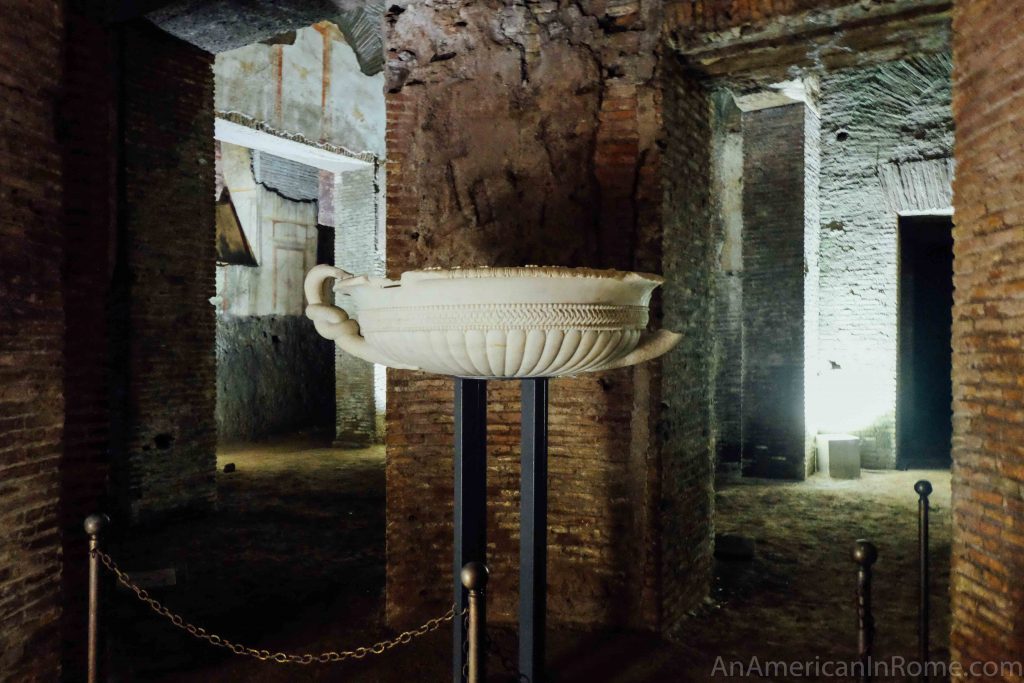
Many of the original decorations from the Golden Palace have been lost or moved to museums, but it is still incredible to wander through the chambers that are now underground.
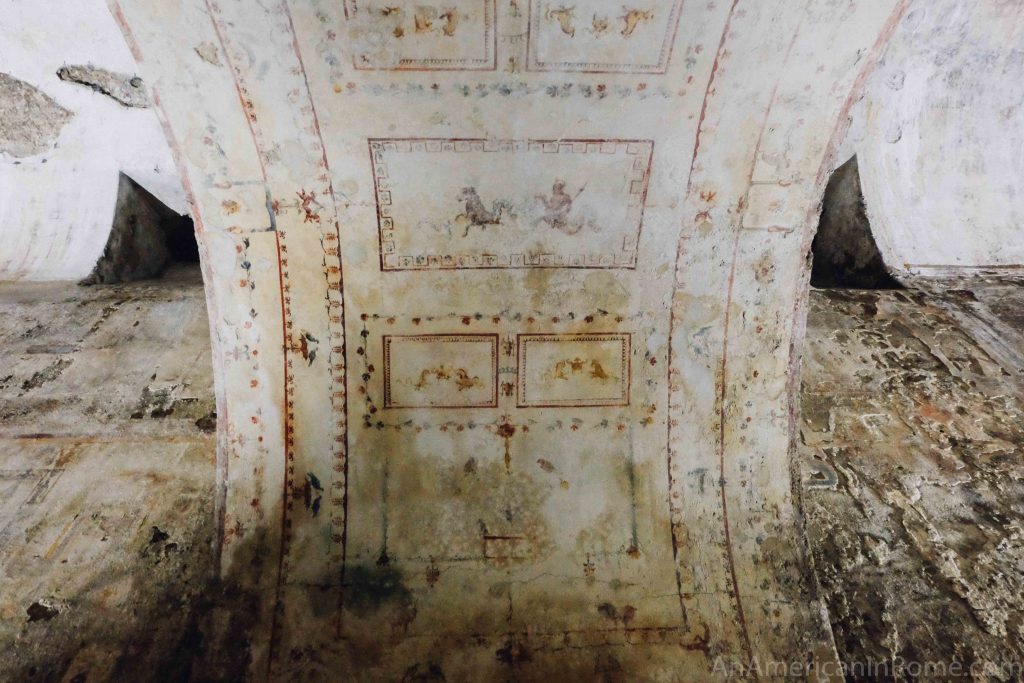
A tour of the Domus Aurea is a great rainy day activity since it is all inside, but a walk through the Golden Palace is also perfect in summer. You might notice in the photos that we are wearing sweaters or draped with scarves – that is because the Domus Aurea is significantly cooler than the outside temperature.
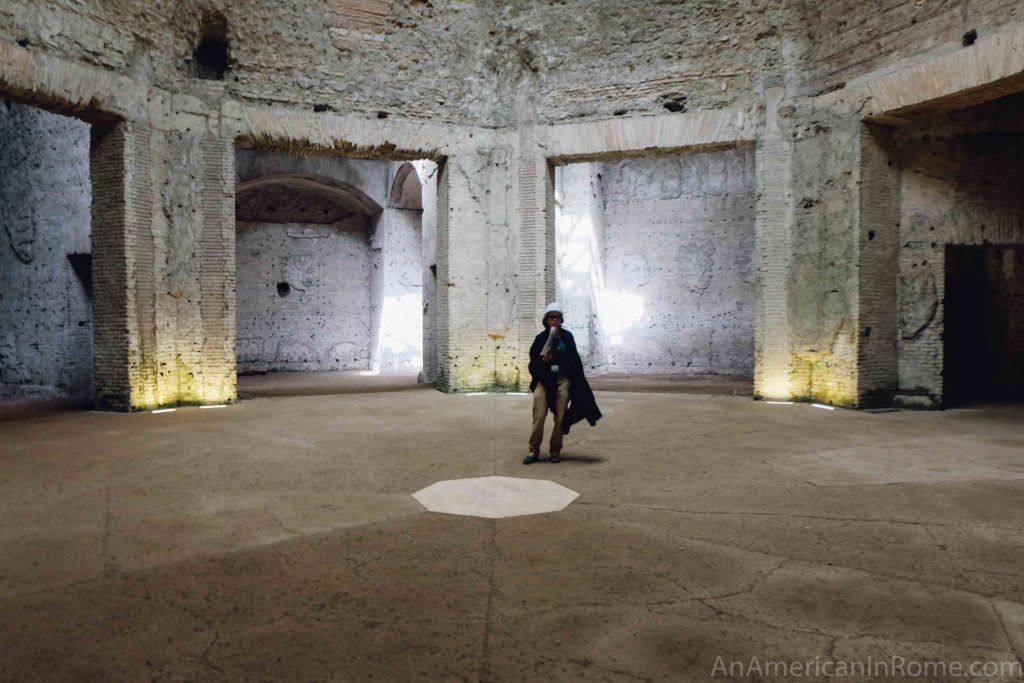
While I loved the virtual reality, my favorite stop was in Nero’s insane octagonal dining room. This is where guests would have been showered with rose petals from the spinning dome above them – much like the rose petals at the Pantheon .

If you have already seen the Colosseum – the Domus Aurea should definitely be your next stop. For the most full-service option, you can book with a company like Through Eternity. You can also buy tickets yourself here and will still be guided by an archeologist once you are inside, or book directly with CoopCulture for the lowest price if there are spots left.
Disclosure: I was invited to join the tour by a friend – but I talk about how much I liked it so often that my husband is now dying to go himself. It is a great experience! This post may contain affiliate links but they represent my honest opinion.
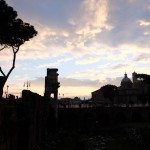
Natalie is a food and travel writer who has been living in Rome full time since 2010. She is the founder and editor of this blog and prefers all of her days to include coffee, gelato, and wine.
7 thoughts on “ Visiting the Domus Aurea: Nero’s Golden Palace in Rome ”
Thank you for sharing your experience and pictures, but please next time leave the history to historians. Even a very brief scan of Nero’s Wikipedia and Encylopedia Brittanica pages would show you how poorly you come across parroting information that has always been known to be salacious gossip.
Nero was not hated. He was beloved. Rome refused to believe he was dead. They created a King Arthur/Christ myth about him that he would return to save Rome. Parthia almost went to war with Vespasian’s son because it refused to say he was dead. They were still laying flowers on his tomb in the 4th century, 300 years after his death. The Collosium got its name because it stood beside Nero’s Collosus. In 700 AD, the Venerable Bede in Britain wrote that, “So long as the Collosus still stands, so shall Rome. When the Collosus falls, so shall Rome and thus the world.” Commodus replaced Nero’s head with his own, but when ge died, Rome put Nero’s head back on. The head was bigger than the Statue of Liberty’s. They stored that giant head just waiting.
Nero gave slaves the right to take abusive masters to court and refused to allow the Senate to pass a law that would give them the right to re-enslave freedmen. He was Rome’s greatest builder and most of his projects were so ambitious they could not be finished until the invention of dynamite. He owned the land the Domus Aurea was built on. It was built in the foot print of his own house, the Domus Transitoria, that burnt down. The Domus Aurea’s Octagnonal Room is an architectural and engineering marvel. The Domus Aurea was 16,000 sqft. The White House is 40,000 sqft, Versailles is 88 million sqft. The vast majority of the Pallantine and Esquiline hills after the fire he turned in to parkland open to the whole city. It is not even clear that the Domus was even a residence, no bathrooms or kitchens have ever been found. Tacitus said he lived in a villa.
Nero was not in Rome at the time the fire broke, he rushed back ASAP, dismissed his body guards to help fight the fire, and ran all around they city organizing fire brigades. After the fire, he fed and housed the homeless on his own property at his own expense. After the fire he created Rome’s first building code, which created the Rome we know of today.
The Domus is a marvel, it is shame that is completely lost by the “Evil Nero” narrative surrounding the pictures.
Ciao! I completely agree about leaving history to the historians which is why I have tried to be as light without being inaccurate as possible.
I didn’t want to get into Tacitus or why he may be a more reliable historian than others who have written about the Great Fire. Or why Nero was so unpopular with the upper class (and how it is the upper class who writes history). Or why he had a Colossal statue of himself by his lake. Or why either he depicted himself as the sun God or Vespasian tried to erase any trace of him and changed the statue. Or why he killed his step-father, mother, and wife and was pretty horrible in his personal life but also pretty good to the wider Roman population.
But I do note that he didn’t live in the palace and it is true that he took advantage of the fire’s destruction to use the space to create his great landscaped palace.
Apologies – but I think people should go to the Domus Aurea to hear it from the researchers themselves!
Hey Natalie! Thank you for writing on your experience. This has been very helpful!
I just did a project on this building for Latin class and this article was helpful! Thank you!
I’m glad and I hope you get to visit in person one day!
Hi Natalie! Thank you for this post! I will be sure to go check it out as soon as I can get back out travelling again, Best wishes xx
I went to a high school prom in the 1970s at a restaurant if the same name at the top of this site. The view was spectacular! Sadly, it, too, burned down.
Leave a Reply Cancel reply
Your email address will not be published. Required fields are marked *
This site uses Akismet to reduce spam. Learn how your comment data is processed .
- Ferragosto - August 15
- Holidays in Rome
- Where to Stay
- Where to Eat
- Best Time to Visit Rome
- Top 10 Tips for Rome
- Bathrooms in Rome
- What to Pack & What to Wear
Money Matters
Getting Around
Getting to Rome
- Learn Italian
- Rome & Vatican Tours
- Italy Tours
- Transfers & Transport
- Sign up & get a FREE ebook Subscribe Today! Our New Italy Travel Website Is HERE Visit Napleswise Now!
- Romewise Home Page
- What to Do in Rome
- Domus Aurea
Domus Aurea - Nero's Golden House A Rome Must See!

By Elyssa Bernard
Updated April 15, 2024
The first time I visited the Domus Aurea in 2002, I knew I was lucky to see such an extraordinary site from Ancient Rome.
I couldn't believe we could go underground and visit this incredibly intact 2000-year old ruin , and see such vivid paintings and well-excavated rooms.
I was awed by the details I could see in the ancient artwork, and the octagonal room with oculus in the ceiling that was so clearly a precursor to the Pantheon .
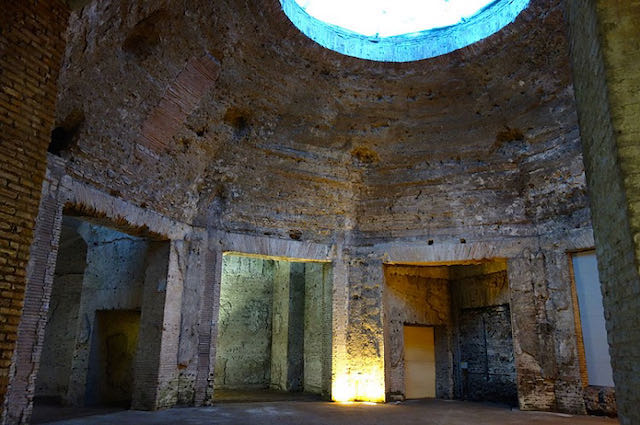
Well, I was right.
It was short-lived.
They shut the whole site down to visitors due to too much exposure devastating the ruins.
I thought it was closed for good.
Since then, there has been a lot of work restoring the Domus Aurea.
It's become one of the most spectacular things you can do in Rome !
The Domus Aurea - What You Need to Know
- What is Nero's Golden House? Why visit it?
- What is it like to tour the Domus Aurea ?
- How and when to visit and how to get tickets
- Is the Domus Aurea wheelchair accessible ?
- Where is the Domus Aurea ?
What The Domus Aurea is and Why you Should See it
Picture Rome in 64 CE.
Nero is emperor.
Yet another fire sweeps through Rome (this happened a lot back then.)
This time, the 6-day fire destroys huge amounts of land across the Esquiline, Celian and Palatine Hill s.
Once the fire is out, Nero figures it's the perfect opportunity to build his opulent house of gold.
Just for him (that is a lot of ego even for a Roman emperor!)
Nero's Golden House
Imagine a vast space, probably larger than 4 football fields, that has nature parks, marble-covered pavilions, statues, fountains, sculptures, and atria.
We are talking about a massive complex of buildings, man-made lakes, gardens, porticos, all glimmering with white marble, ivory and precious materials brought in from around the empire.
That villa became known as the Domus Aurea (literally, from Latin, "Golden House.")
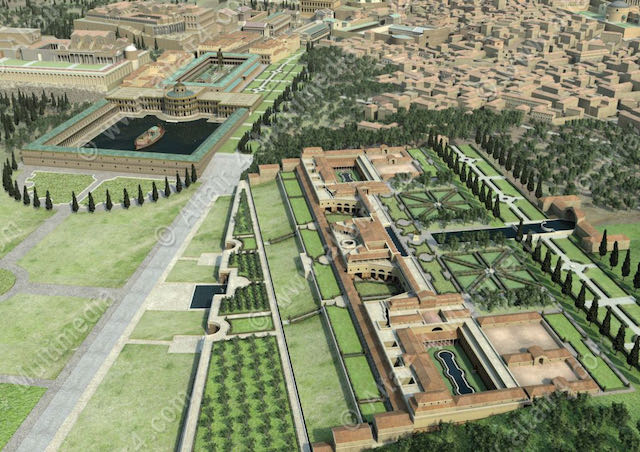
A villa in Rome is not necessarily one building.
The word "villa" in this case usually refers to a large expanse of park space, or rather an estate, in which a wealthy family builds at least one if not many complexes to live in, entertain in, relax in, and just enjoy.
The Villa Borghese in Rome is an example of a "villa" that is in fact a huge park.
The Domus Aurea was anywhere from 100-300 acres.
Most of it has not been excavated but apparently it occupied much of the area we think of today as "Ancient Rome", i.e. the Palatine Hill , the Esquiline Hill and the Caelian Hill.
This includes where the Colosseum is now.
(During Nero's reign, the Colosseum had not yet been built.
There was a huge man-made lake there instead .)
Originally, it was thought that Nero's villa was simply a gigantic place for entertainment, as they had not found sleeping quarters.
But during one recent tour, the archeologist did in fact speak of possible sleeping quarters.
So much is still to be discovered about the use of all the spaces there.
Why "Golden House"?
Nero used gold leaf as decoration in many parts of the villa.
Also, most of the structures were composed of white, sparkling marble, and adorned with ivory and jewels.
And finally, the whole thing was exposed to streaming sunlight.
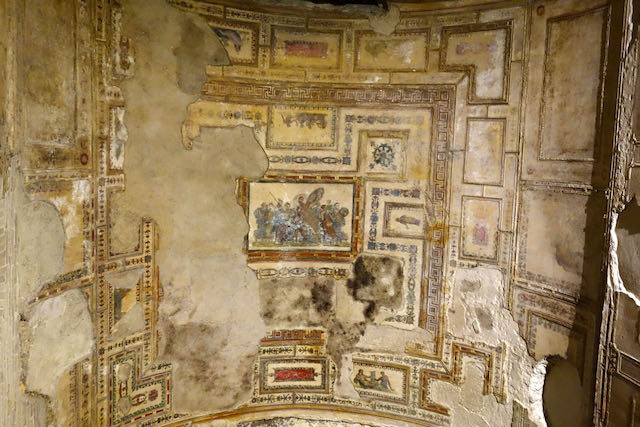
Today it's underground, but when Nero built and used it, it was on ground level.
So between the white marble, gold leaf, shimmering jewels, and the brilliant sunshine pouring in, the idea was to make this a "golden house."
A house that shined.
This fantastic website, Realm of History, does 3-D recreations of some of Ancient Rome's sites, as they might have been.
Take a look .
What happened to Nero's villa?
Nero was probably insane.
He'd killed his mother, killed his wife, and behaved pretty erratically.
In 68 CE he was driven out of the city and forced to commit suicide.
After his death, the senate issued a " Damnatio memoriae ", a Latin phrase meaning "to condemn his memory."
In theory, Nero and all he did was to be obliterated so Rome could get back to being a stable, growing empire.
There was a shaky "year of the four emperors", where the first 3 after Nero kept getting killed one after the next.
But the fourth, Vespasian, who took reign in 69 CE, founded a stable dynasty: The Flavian dynasty.
One of Vespasian's ideas to help erase memories of Nero was to get rid of Nero's giant lake.
He said (something like), hmmm, let's fill in that pond and make a cool arena we can use for spectator sports.
The people will be amused and entertained and forget about all that craziness and instability.
This arena was known then (and still is) as the Flavian Amphitheater (named for the Flavian dynasty which Vespasian began.)
And eventually, it became known as the Colosseum , perhaps because of the colossal statue of Nero that stood there for a while .
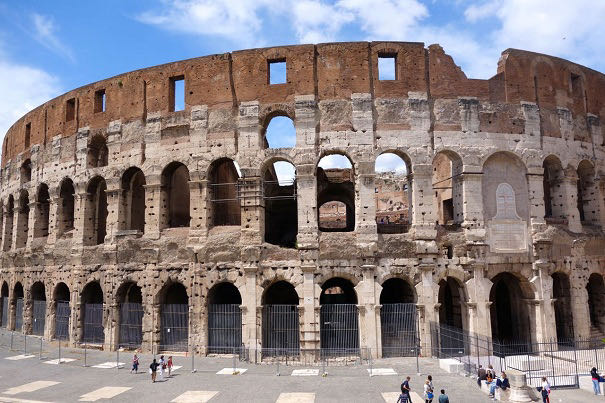
Subsequent emperors ( Titus and Domitian ) built more things on top of the ostentatious ruins left behind by Nero, and finally, the Emperor Trajan , said, all right, this has all got to go.
(This was typical of emperors, and frankly, later, popes, who each wanted to leave his own mark on the city, and so, destroyed or built over what his predecessors had done.)
So Trajan had all the spaces filled with dirt and brick - which reinforced the walls and created a solid base - and built his baths on top.
Today you can see what's left of those baths in the Colle Oppio.
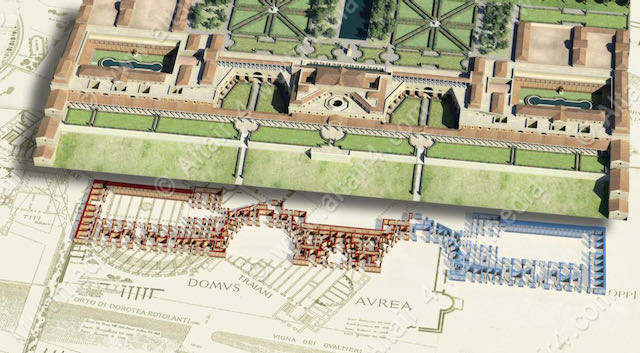
This is one reason the area underground is so well preserved.
If Trajan had not had the placed filled in and reinforced, much of the architecture and art would probably have been long ago lost.
When the Domus Aurea was first discovered in the late Renaissance
I just love this story.
Apparently sometime in the Renaissance, a young Roman man fell into a crevasse in the ground, and found himself staring at ancient frescoes on the rubbly walls around him.
When word got out, the artists in Rome of the day, including Pinturicchio , Raphael and Michelangelo , all lowered themselves in there on ropes, and walked around on top of the rubble (put there by Trajan.)
They gazed at the art, and took with them ideas for their own works.
The style of art we think of today as Grotesque comes from this, because the artists said it was like being in a grotto, or cave.
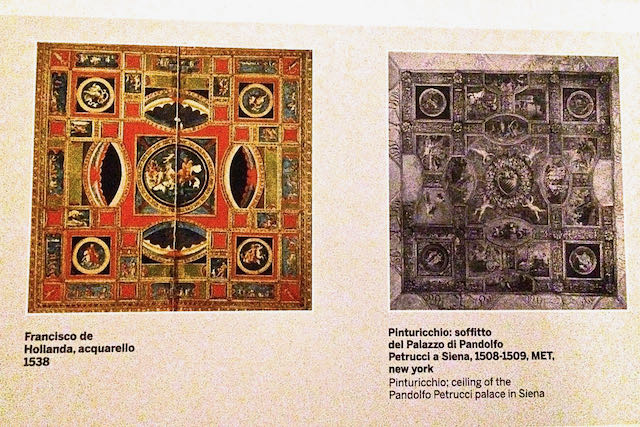
The perfect 3-day itinerary in Rome
Trying to figure out how to organize your visit to Rome? I've got the perfect 3-day itinerary for first-time visitors (or those who have not been here in a while.) It works for a 2.5 day visit as well.
In my 3-day itinerary, you'll see all the major must-see Rome attractions like the Vatican , Colosseum , Trevi Fountain , Pantheon , Piazza Navona , Spanish Steps , Castel Sant'Angelo , and much more.
And if you have more time, or want suggestions for extra/other things to do, you'll find that there too.
Visit my page with the best 3-day itinerary in Rome for first-timers .
Influence on later art and architecture
A lot of what Nero did when he had his villa built influenced later art and architecture in Rome and in Italy.
For me, this is one excellent reason to visit the Domus Aurea- It really ties together Rome's ancient past with some of the things you may already have seen in Rome:
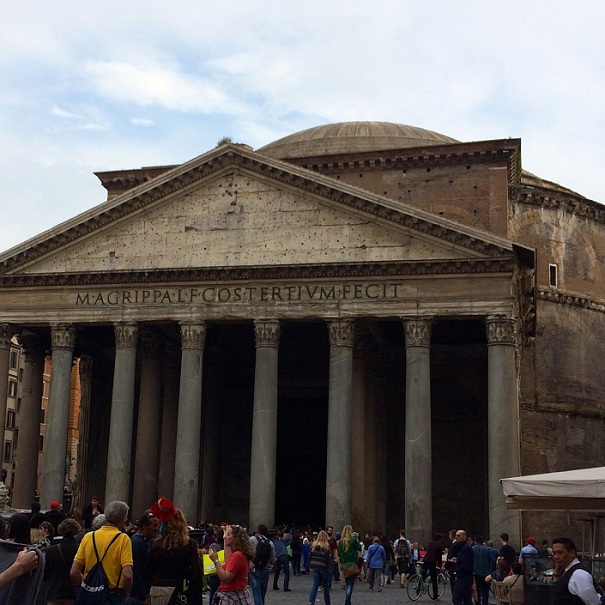
First of all, there is the octagonal complex , with its open oculus in the ceiling to allow light in.
Remind you of anything else in Rome?
Like the Pantheon ?
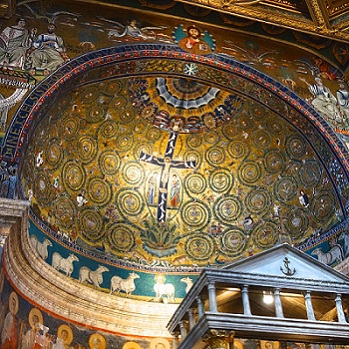
Second of all, Nero went against the trend at the time of laying mosaics only on the floor . . . and used them to decorate the ceilings as well.
Later, byzantine-style mosaics would be used this way to decorate church apses around Italy.
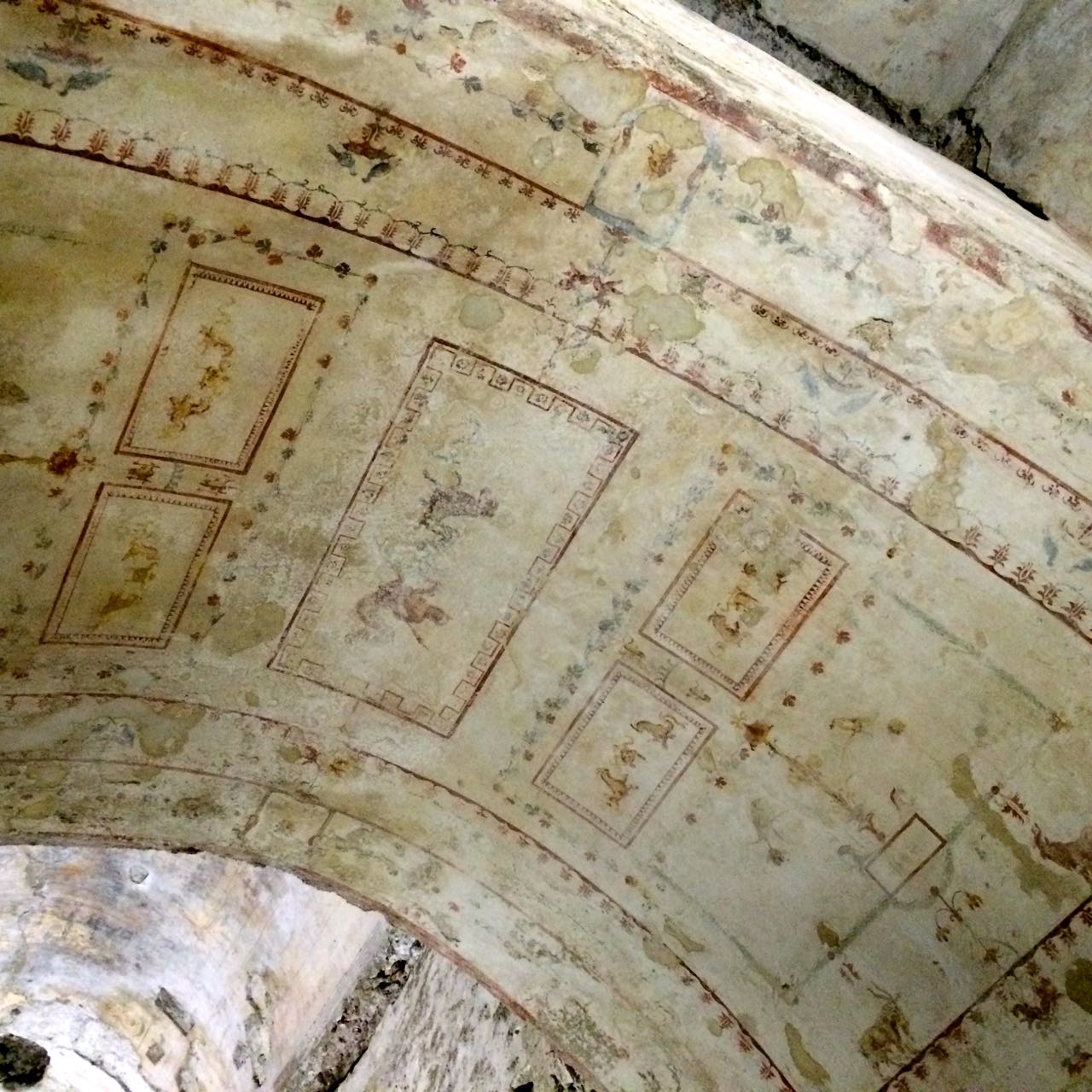
Third, the villa was rediscovered during the Renaissance (as I wrote just above), and many painters at the time took ideas from the paintings they saw on the walls there.
Most famously, Raphael's rooms in the Vatican take a lot from the designs he saw on the ceiling of the Domus Aurea.
An archeological site today
The Domus Aurea is today an active archeological dig and restoration project.
Luckily, we can visit these ruins, with a knowledgeable archeologist, who will give you an excellent and very thorough tour of the main catalogued and opened spaces of this vast underground complex .
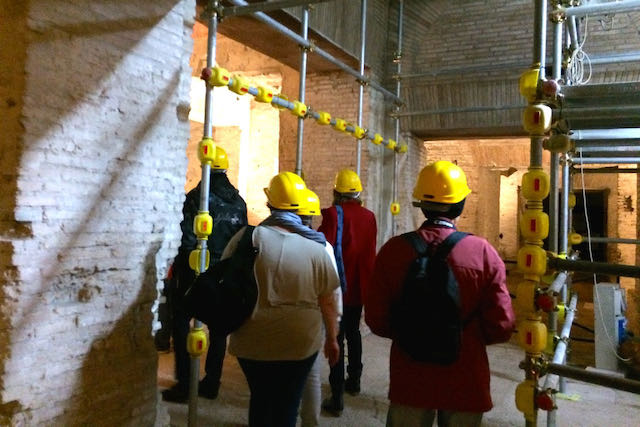
It is really worth fitting this visit into a trip to Rome, and I would definitely classify it as a must-see in Rome , especially if you like the ancient stuff.
You get a much more intimate and closeup, and also un-crowded view of what once was the splendor of Nero's Rome.
What it's Like to Visit the Domus Aurea
I will just say "wow."
The Domus Aurea was already one of my favorite Ancient Rome things to see.
But now, with the addition of virtual reality goggles , this site visit has jumped to a whole new level of AMAZING!
When you first arrive for your visit, you will be given a hard-hat to wear.
I guess this is just a precaution, as I cannot see anything falling on you.
Even the guide will wear one.

Your guide will be one of the archeologists actively working on the site.
So he/she is really in a position to know all the details.
In fact, each time I've done this visit over the years, the various guides have provided different and new information as more is discovered.
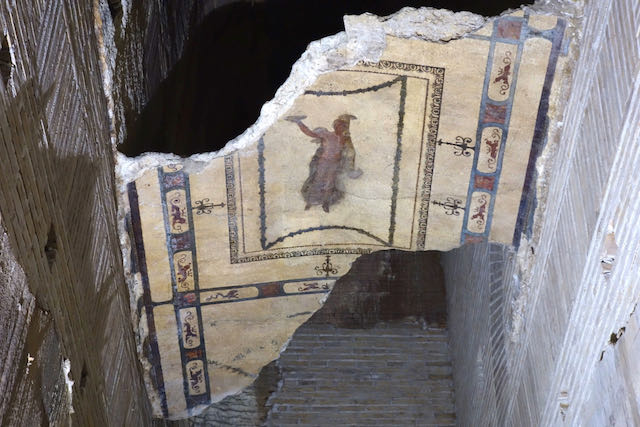
The spaces are large, and it's not claustrophobic at all.
It is however, chilly in there.
And it can be damp in parts.
So if it's hot out, this can be a great way to keep cool !
Just remember to bring a sweater.
No matter what season you visit Rome, here are 4 essential things we recommend never leaving home without:

Disclosure: If you make a purchase through a link on this page, I may receive a small commission - at no extra cost to you. Thank you for supporting my site!
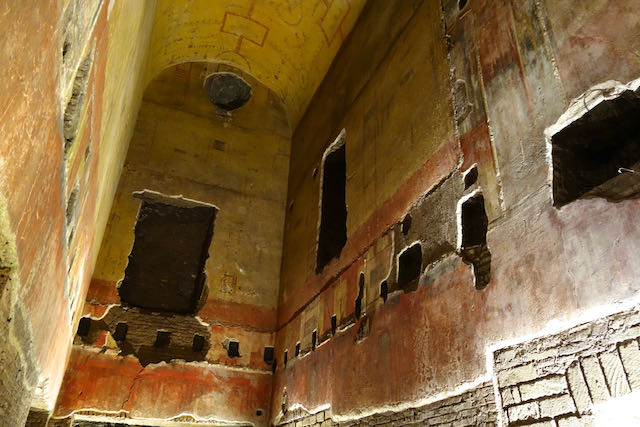
In one of the rooms you will sit down and put on virtual reality goggles .
This is the part about the visit that makes the whole thing a must-see in Rome.
The narrator will take you through (in English) the ruins you are sitting in, but make it look as it did in the past.
You will feel transported, as if you are flying around and looking at the huge complex from a drone.
It's one of the most amazing things I've ever done in Rome and I cannot recommend this highly enough!
Ready to plan your trip?
Book your train.
Planning to travel between cities in Italy and other parts of Europe?
Use Trainline to see all the different options available across the different rail companies.
Find your hotel
Find your perfect place to stay in Rome.
Use Booking.com to choose between hotels, guesthouses, and self-catering apartments in neighborhoods throughout the Eternal City.
Buy your TurboPass
Purchase the convenient Turbopass and visit all of Rome's top attractions including the Colosseum, Pantheon, and Vatican.
With one handy pass, it's all included.
How and When to visit
I cannot stress highly enough how you need to plan ahead for this .
And in high season, plan way ahead!
When to visit
The excavations are open to the public for guided tours only on Fridays, Saturdays and Sundays .
They are closed December 25 , January 1 , and May 1 .
During the week, they are actively working on excavating and restoring the site, so you cannot visit it then.
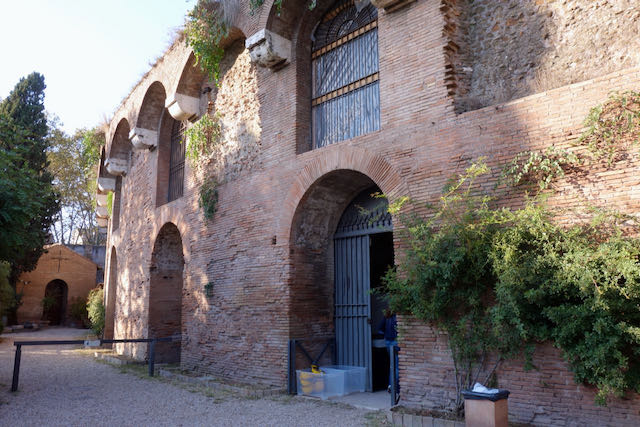
🔐 Store your bags and luggage securely! 🧳
We're parterned with Radical Storage who have locations across Italy for you to keep your luggage safe before and after check-in, while on day trips and for everything else between 👌
Click here to book now and use code ROMEWISE to save 5%!
As the guide explained to us on our tour, they finally re-opened it to visitors because, frankly, they need the money to help pay for these works!
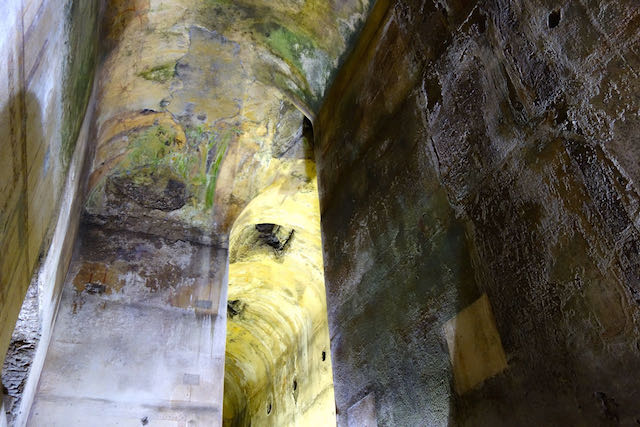
You may visit on Fridays, Saturdays, and Sundays on a scheduled visit with an authorized guide from the site, between 9am and 5pm.
( Visit my page about Underground Rome to find more places to visit, including places you can visit without a guide .)
Appointments are available for groups of maximum 25 people, every 15 minutes, in English, Italian and Spanish.
Last admission at 3.45 pm.
The tour lasts about 1 hour and 20 minutes.
Want to see some other cool immersive light shows in Rome?
Visit my page with lots more options !
How to reserve tickets
Admission is 18€.
I strongly recommend pre-booking .
This is a very popular site, and although they are offering visits throughout the day on Fridays, Saturdays and Sundays, there is a maximum of 25 people allowed per visit, and you risk not getting in if you just show up.
Also, it's a good idea to book in the language you want.
The guides give a lot of information and speak quickly, so you will need to keep up!
The fee includes the guided tour and the virtual reality portion .
For tickets, visit Parco Colosseo
If they are sold out, you may try with a tour company (see below).
The Domus Aurea is not one of the sites available for free or reduced entry with the Roma Pass .
Also, it is not one of the sites that participates in the " Free Sunday at the Museum ", held the first Sunday of each month, in which state museums and sites are free.
Colosseum Ticketing Update April 2024
A brand new ticket system has been launched for tickets to the Colosseum, Roman Forum, Palatine Hill and Domus Aurea - check it out here .
A few things to note with this new system:
1. It only applies for tickets from May 1 2024 onwards . If you want to purchase tickets for April 2024, you will need to use the old CoopCulture website.
2. Tickets are currently being released a month out, day by day . On April 8 tickets for May 8 became available, on April 9 tickets for May 9 get released and so on.
3. The new website has a system which puts visitors in a digital queue before letting them on to the site itself, to stop the site crashing due to demand, so don't worry if you don't get onto the site immediately.
4. Not all ticket/tour options are available to purchase yet so keep checking back if what you want isn't available.
Reserve Domus Aurea Tickets Through an Agency
Do you just want to book your Domus Aurea ticket and be done with it?
Have it arrive on your mobile device?
There is an easy way to do this, even if it costs a little more than booking through Parco Colosseo.
Is the Domus Aurea wheelchair accessible?
According to the Domus Aurea official website, Parco Colosseo , " The site is partially accessible to the disabled with wheelchair."
Since they are constantly excavating, and sometimes changing the itinerary, the accessible parts may also change.
Just be aware when booking that you may not be able to visit all the places covered on the tour.
Other important things to know regarding the use of the virtual reality goggles is that it is not recommended for children under 13, or to anyone with epilepsy or serious eye diseases.
Where to find the Domus Aurea in Rome
The Domus Aurea is on the Colle Oppio, just next to the Colosseum .
It is easily accessible from the Piazza del Colosseo, by walking through the gates of the Colle Oppio park.
Want to save this to Pinterest? Pin it here!
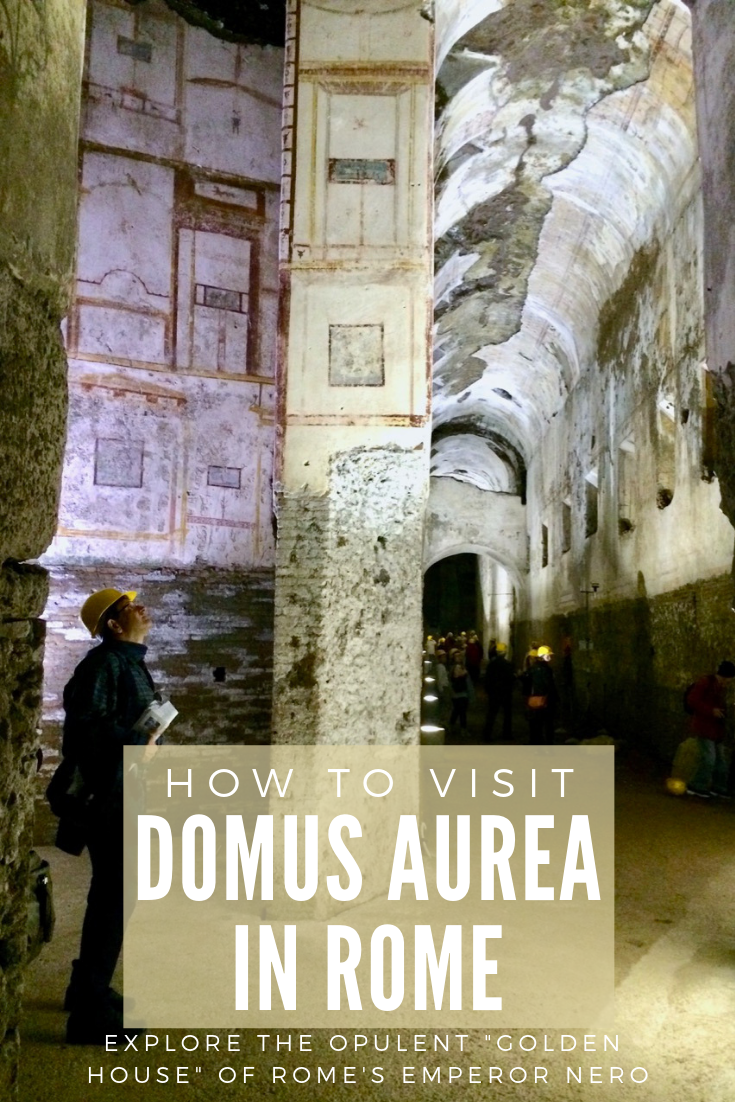
Romewise's Top Travel Resources
Ready to book your trip to Rome? Take a look at these helpful links to companies we use and trust:
- Keep your travel spending simple with the Wise card, which removes all the worry about exchange rates and high transaction fees all over the world
- Search for and book your perfect accommodation
- Our complete guide to what to pack for Rome
- The number one travel accessory, a multi-point travel adapter and voltage converter
- Browse a huge range of tours in Rome and beyond
- Experience unique tours and special access to Rome's most popular sights
- Protect yourself with comprehensive travel insurance
Within this post there are some affiliate links for products and services. For more details about our affiliate policy click here .
Get your 100% free Rome trip planner now!

Simply sign-up today for our free newsletter and get the Romewise Quick Start guide to Rome:
We are committed to respecting your data. Click for our Privacy Policy .
Comments? Questions? Suggestions?
Please come over to the private Romewise Facebook group and join in the conversation.
You will often find me there, happy to answer your questions / comments!
You will also meet other Rome lovers and experts, too.
What are you waiting for?
Come join in the fun !

Read here about our sponsorship policy
Top attractions and tours

- Colosseum - Don't miss visiting Rome's most iconic monument
- Vatican Museums - This is where the Sistine Chapel is
- Pantheon - Book ahead and skip the line
- Galleria Borghese - You'll need to book ahead for one of Rome's best museums
- Castel Sant'Angelo - See Rome's history through its architecture
- Rome City Pass - A great way to make your Rome visits easier
Disclosure : If you make a purchase through a link on this page, I may receive a small commission - at no extra cost to you. Thank you for supporting my site!
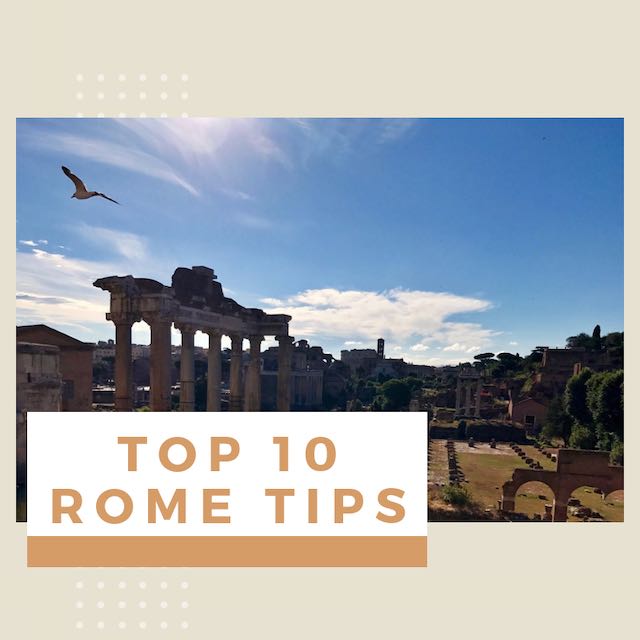
New to Romewise? Start Here
Get the most out of Romewise
Coming To Rome?
Weather in Rome
Accommodation
Already in Rome?
Things to Do
MORE CITYWISE WEBSITES:
Florencewise
Atlantawise
Citywise LLC
Home | About Me | STORE | Privacy Policy | Legal Disclaimer | Affiliate Disclosure | Contact Me
Copyright © 2009-2024 by Elyssa Bernard, Romewise.com | All Rights Reserved.

Domus Aurea: Nero's Golden House Guided Tour
Go into the Domus Aurea , or Golden House, created totally for pleasure by Emperor Nero, a man well-known for jaw-dropping acts of indulgence.
Join an expert guide to discover the Domus Aurea, or the Golden House, designed purely for the pleasure of Emperor Nero, and find out about the history of the site and its remaining riches on a walking tour.
After meeting the guide at the meeting point and exchanging your voucher for your entrance tickets, you can start discovering the Domus Aurea which must have been one of the most aesthetically breathtaking buildings ever constructed.
It is home to several decorative artworks such as mosaics, marble furnishings, and even a rotating dining room. You can listen to the tales about the richness in a house where everything was coated with gold and adorned with gems, shells, and ivory. As you walk, you can also learn about the extravagance of Nero during the construction of the Golden House, which included a 120-foot colossal statue of Nero in the vestibule.
Alongside the architecture, you can visit the peaceful lake, fields, vineyards, pastures, and woods filled with all kinds of wild and domestic animals, as well. At the end of the tour, you’ll understand why Nero was so charmed with the house that he declared “Finally, I begin to live in a house worthy of a man.”
- Visit Nero’s Golden House, or the Domus Aurea, and see the marvels on site,
- Get the most out of your experience on a guided walking tour,
- Learn about the site’s luxurious history and the excavations currently taking place there,
- See the remains of the spectacular adornments including intricate frescos and marble walls,
- Find out about the site’s underground lakes, spa baths, and rotating dining room.
Free cancellation (up to 24 hours)
We shall never know for certain whether Nero caused the fire that devastated Rome in ad 64 or simply profited from it to seize 160ha (400 acres) of the gutted city to build himself the most luxurious residence ever seen in Rome.
All we can say is that the legend about Nero fiddling while Rome burned is apocryphal, and that no other European monarch has ever carved himself out a larger slice of his capital for his private use. Apart from the facade covered in solid gold, the Emperor’s pleasure palace had such refinements as baths with hot and cold running water either sea or fresh or fed from sulphur springs, hidden perfume sprays piped into the reception rooms, and a mechanical device for showering flower petals upon his banquet guests.
The gloomy chambers of the ruins of Nero’s palace are mostly underground today. Trajan built his public baths on top of the ruined Golden House when it too was destroyed by fire in ad 104.
Thirteen centuries later some of the rooms in the palace were rediscovered and the painted decorations caused an artistic sensation – it was the first time in over a thousand years that anyone had cast their eyes on the style that later became known as ‘Pompeian’ . Raphael used the decorations as his model in the Vatican Loggie without knowing he had been copying wall paintings from Nero’s Palace.
As you walk through the cavernous cryptoporticus and through the octagonal hall a powerful pocket lamp will be invaluable in identifying the now much faded paintings. The famous Greek sculpture of Laocoon now in the Vatican museums was discovered here in pieces in 1506. It most likely formed part of Nero’s splendid art collection.
from €18.00 EUR Closest Date: August 17 Validity: 24-hour Seller: Parco archeologico del Colosseo
from €1200.00 EUR Duration: 3.5 Hours Organized by: Enjoy Rome
You are using an outdated browser. Please upgrade your browser .

- Skip the line tickets
- Palatine Hill
The Domus Aurea Rome: All about astonishing Nero’s palace
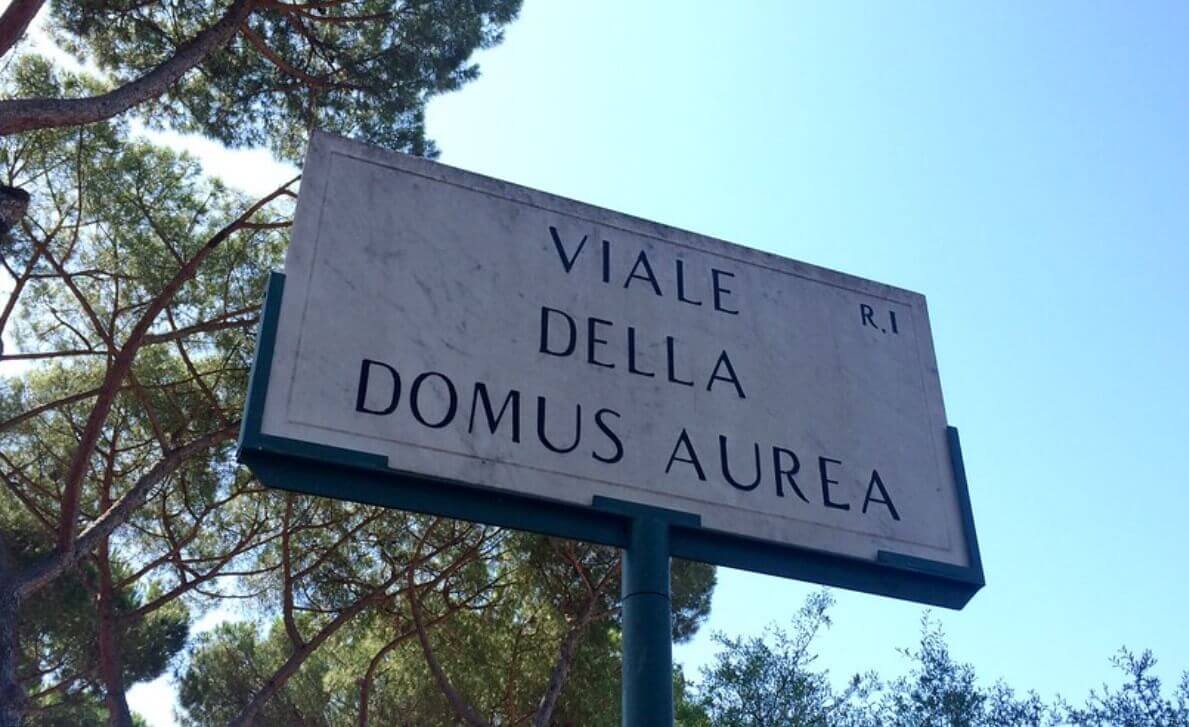
- In Palatine Hill Skip the line tickets
You want to know more about Domus Aurea ? In 64 AD, Rome suffered a great fire. It was the summer, and the blaze lasted for nearly 10 days. It is estimated that over 66% of the city was destroyed . As the majority of Rome’s buildings were wooden framed, only 4 districts escaped devastation.
Rumours abound that Nero himself has destroyed the city. But if true that also meant it destroyed Nero’s palace in Rome – the Domus Transitoria…
- 1 History of the Domus Aurea
- 2 About the Emperor Nero
- 3 What does Domus Aurea mean?
- 4 Details about Architecture and Layout
- 5 2 Little-known Domus Aurea facts that even the tour guides forget
- 6 Nero's Golden House
- 7 How do I buy Domus Aurea Tickets
- 8 Info about Domus Aurea Hours
- 9 Domus Aurea map & How to get there
- 10 3 Best hotels nearby to Nero’s house that you can BOOK right now!
- 11 Frequently Asked Questions
- 12 Conclusion
History of the Domus Aurea
Nero died in 68 AD, at which point the construction of Nero’s Domus Aurea was nearly complete. Word has it that he took a detailed interest in what was going on in Nero’s house, paying attention to every detail.
Severus and Celer were appointed as architects. They were tasked with building a sprawling home that covered part of the Palatine hill and covering more than 1.2 kilometres.
About the Emperor Nero
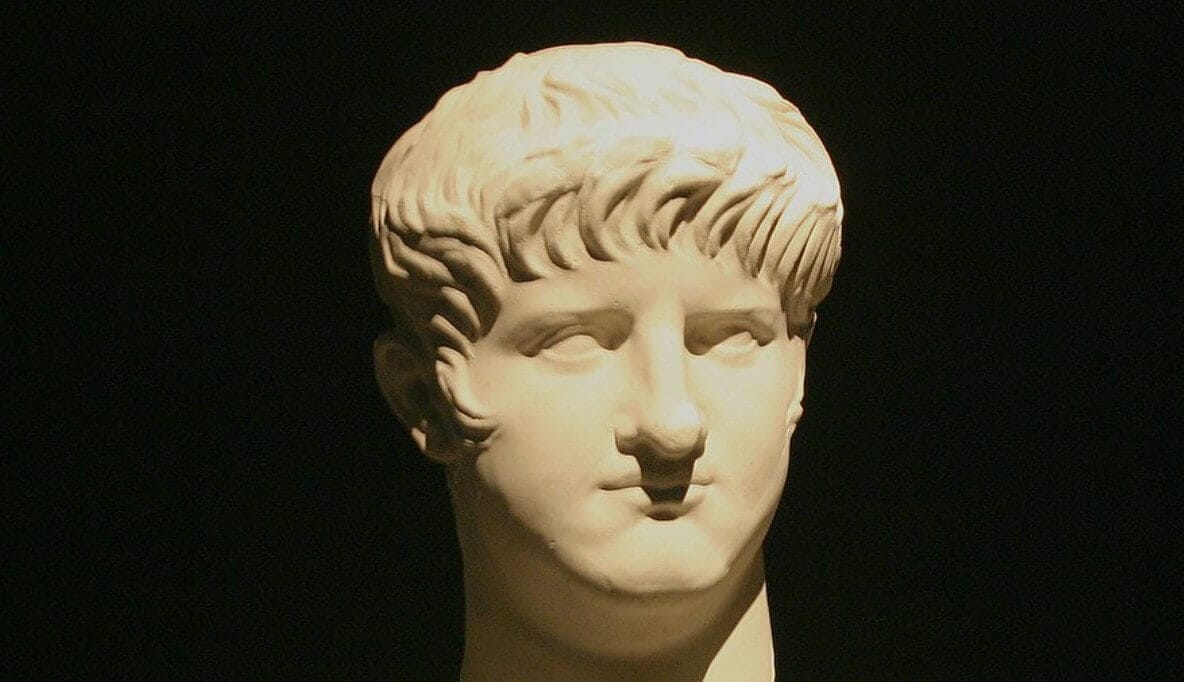
Nero ruled from 54AD to 68AD, from the tender age of 16. Due to his young age he was guided by his mother for the first few years. Then he killed her . Oh, and he killed a bunch of other family members too, in order to consolidate his power.
In later years, following the 64AD fire, he imposed heavy taxes in order to pay for the reconstruction. This included Nero’s golden house reconstruction. Of course, this was unpopular and led to a rebellion. He eventually committed suicide.
What does Domus Aurea mean?
Nero’s Domus Aurea means Golden House in Latin. It is known as such as the interior was not only caked in gold, but also elaborate marble and gemstones.
Details about Architecture and Layout
You’ll definitely need to make use of a Domus Aurea floor plan when visiting, as the area is vast. Check out this location map here to help you. The golden palace of Nero had a bunch of over the top design elements.
Here is a list of a few of them below:
- a literal countryside landscape in the city-pastures, lakes and vineyards
- a 30m high statue of the man himself over 300 entertainment rooms
- internal fountains set against backdrops of white marble , angled to reflect the light
- mosaics for the first time were put on the walls and ceilings, not just on the floors
- a huge dome was designed above an 8 sided octagonal courtyard
- underneath the dome there was a moving ceiling that dropped rose petals on those being entertained below! The ceiling was moved by slaves using a pulley system
2 Little-known Domus Aurea facts that even the tour guides forget
- the palace contained – at least it is thought – no bedrooms ! it seems it truly was designed as a ridiculously huge party house
- a young man was taking a stroll through Rome in the 15th century and fell into a hole. He had inadvertently discovered Nero’s palace . Soon, people were queuing up to get into the pit to see the Domus Aurea paintings
Nero's Golden House
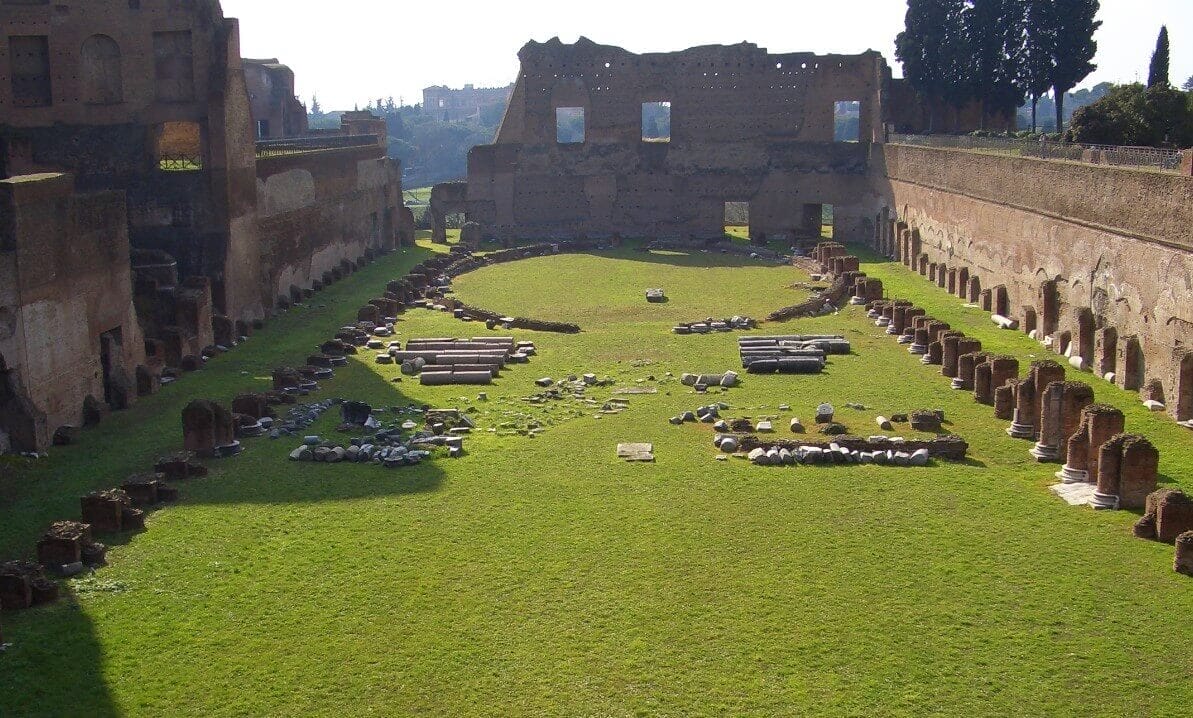
Check out some of the online virtual tours available here to help you get a sense of scale.
Reconstruction
To get a sense of just how huge the sprawling complex was, you can check out this pretty detailed reconstruction video here.
Paintings and Frescoes
Another great video here will show you just how opulent the paintings and frescoes inside the Domus Aurea were.
The Domus Aurea today

Here is a really nice 4K tour of the Domus Aurea as it stands today. You can clearly see in some parts the frescoes on the ceilings and floors.
How do I buy Domus Aurea Tickets
Adult tickets cost €14, with reduced fares starting from €10. There is also usually a small reservation fee to pay too. Children under 6 go free. The visit includes a Domus Aurea virtual tour with a virtual reality component.
This lets you see the restored grandeur of the villa. Click here to get your tickets – the price includes the tour guide.
Info about Domus Aurea Hours
The Nero palace is only open to visitors at the weekends, and visits must be conducted via a tour guide.
Tours are at 09.15am and 16.15 on Saturday and Sunday and need to be reserved in advance here.
Domus Aurea map & How to get there
You will find the site within the Colle Oppio park . The best way to get there is through the Via Labicana entrance. Take Metro Line B and get off at the Colosseum if you wish to use the underground. If travelling by bus take number 85 or 175.
3 Best hotels nearby to Nero’s house that you can BOOK right now!
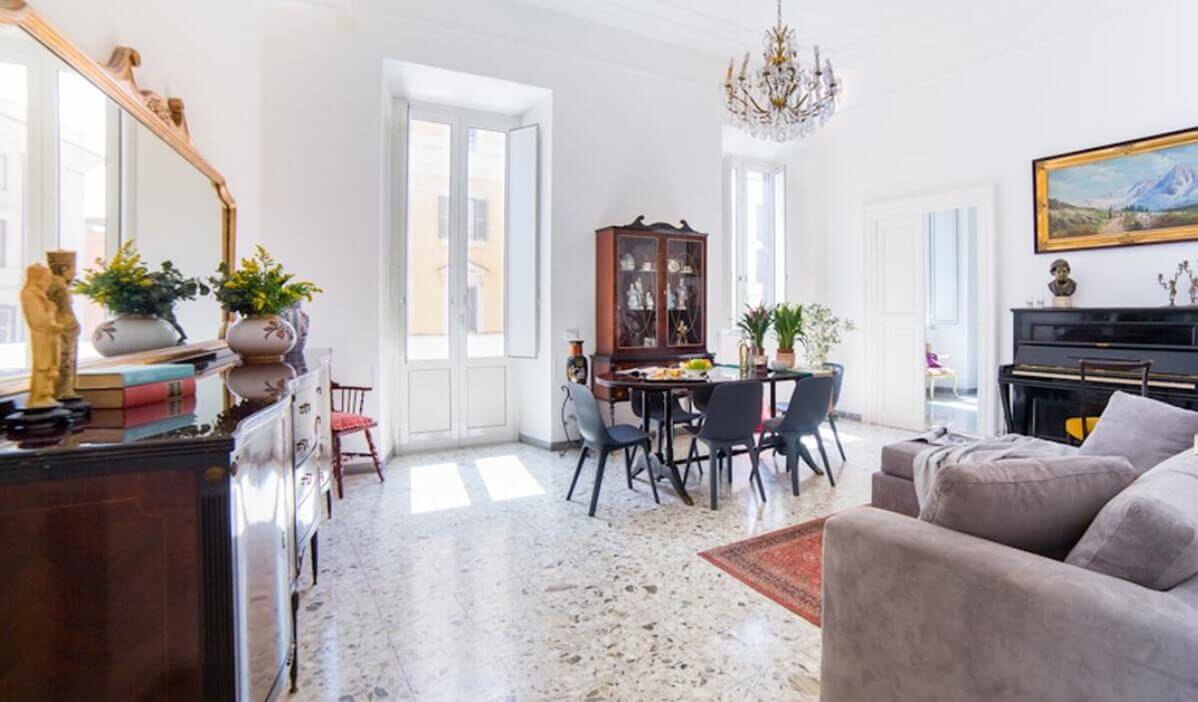
Rome is full of great hotels – but here we’ve selected three of the best hotels near which you can choose!
This charming second floor apartment is located within a stone’s throw of the Domus Aurea and is perfect for those who want more independence. With four bedrooms and beautiful decor, you can play house in Rome for a few days. There is a minimum booking requirement of 3 nights. In spring, this will cost about €1000.
This hotel is part of the Eurostar Hotel group and is a 5 minute walk from Termini station. The decor is simple, but it is the view from the restaurant that makes this hotel special. Rooms start at €133 per night, with breakfast for 9€.
Vinci House
Located just under a kilometre from Nero’s Palace, Vinci house offers superb accommodation. Simple and sleek decor, along with a great location, mean this hotel is a real contender. Get a double room in the spring for €135 euros a night.
Frequently Asked Questions

What is Domus Aurea?
A huge network of part of the partially excavated Nero’s palace.
Where is the Domus Aurea located?
Near the Colosseum, on part of the Capitoline Hill.
Where is the entrance to the Domus Aurea?
Entrance to the compound is accessed via the Colle Oppio Park.
Who built the Domus Aurea?
It was commissioned by Emperor Nero to replace the original palace destroyed in the 64AD fire of Rome.
When was the Domus Aurea built?
Construction began after the 64AD fire and as completed after Nero’s death in 68AD.
Can you visit Domus Aurea?
Visits are permitted only with a guided tour at weekends. Reservations are necessary in advance.
Did the Domus Aurea have windows?
Originally yes, however when the Trajan baths were being constructed the windows were filled in.
How many rooms did the Domus Aurea have?
It is estimated there were 300 rooms - the majority of which were for entertaining.
How tall was the Domus Aurea?
At least 30 metres to hold the massive statue of Nero.
What was the Domus Aurea used for?
It was primarily used for entertaining. In fact, no bedrooms have been recovered, leading historians to conclude Nero never actually slept there.
Visit this fantastic compound of Nero’s when you are in Rome over a weekend. To plan the rest of your trip, check out our extensive guide to Rome’s many other attractions.
Fanny, an ardent admirer of ancient history and architecture, has been fascinated by the Colosseum since her first visit to Rome in 2012. As a key contributor to the Visit Colosseum Rome blog, she brings her passion for the Roman Empire’s monumental legacy to every article and guide.
Leave a Comment Cancel reply
Your email address will not be published. All fields are required.
© Visit Colosseum Rome I 2024
Visiting Nero's Golden House: What To Expect

Your changes have been saved
Email is sent
Email has already been sent
Please verify your email address.
You’ve reached your account maximum for followed topics.
This Underrated Arizona National Park Is Set To Be One Of The Most Popular For 2024
Underrated, but scenic: this small town in tennessee is a great alternative to nashville, 10 scenic upstate new york road trips that should be on your bucket list.
Nero’s Golden House, commonly called Domus Aurea, is a huge palace complex in Rome that was built in 64 AD. The building was never completed, but when it was in its prime it had hundreds of rooms and was fit for an Emperor. While it has been destroyed and rebuilt over time, visitors can still tour what remains of the building while also seeing what is being reconstructed.
Where Is Rome's Golden House?
The Domus Aurea is located inside of the Colle Oppio Park from the entrance Via Labicana in Rome. It is right down the road from the famous Colosseum, where gladiators once fought. There are also a few nearby medieval churches that are worth walking to or getting a taxi to visit.
The Golden House was actually found by a man who fell through a crack into an underground chamber that was part of the ancient building. This has led to multiple artists and archeologists going to the house and learning more about the history of Rome and Emperor Nero’s rule.
RELATED: Major Gods & Goddesses You'll Learn About In Rome
How To Visit Nero's Golden House
The only way to visit what is left of the Domus Aurea is through guided tours in small groups. There is currently construction going on to reconstruct the ancient building, so during the week, they do not allow visitors. Booking tickets online will be a tourist's best friend because this is a popular tourist site and spots will fill up fast.
For tourists who like to stay near the places they are visiting, there are a few hotels near the Domus Aurea that are within walking distance to the entrance of the buildings. Two that pop up that are close to the ruins are 4-star hotels that have high reviews. There are also several places to eat nearby, either before or after visitors go see the ancient palace.
Time And Cost Of Visiting Nero's Golden House
The Domus Aurea can only be visited during certain hours because of the ongoing work to continue restoration on this piece of history. The tours only go in small groups, and spots fill up fast so it is recommended to buy tickets in advance.
- Open: Saturdays and Sundays 9:15 am to 4:15 pm
- Cost: From $33.83
These tours are one-hour guided tours and come with an amazing VR headset that lets visitors see what the Golden House would have looked like when it was fully built. Depending on the website visitors order tickets from, dates and times will vary in availability.
What The Golden House Currently Looks Like
While the building is still under reconstruction, visitors can easily imagine what beauty the place held before it was largely ruined. The architecture is amazing even to the untrained eye and is rich in history.
The Domus Aurea has high vaulted ceilings that were filled in with dirt when it was starting to be destroyed. There are a lot of holes throughout the building that were once used to see its spectacular decorations that now only serve to let bacteria into the buildings, which is slowly helping to tear it apart. The walls and the ceilings are painted in a lot of patterns that have helped archeologists and artists learn more about ancient Roman culture. While there are not hundreds of rooms still connected to the building, visitors can still see several of the rooms that were in the original structure.
RELATED: These Historic Hotels Are The Best In Rome
History Of The Golden House
Emperor Nero had the vision of building a huge palace, full of rooms and lavish furnishings. After the massive fire in 64 AD that destroyed the city center and cleared a large amount of space, Nero started construction on the palace. It was rumored that the emperor himself had set the fire in order to build the palace, which eventually took up hundreds of acres of land without even being completed.
While the huge palace had hundreds of rooms, it was never completed. Emperor Nero committed suicide in 68 AD because he believed he was condemned to die as a public enemy. The palace only stood for four years, and would eventually begin to be destroyed.
Destruction Of The Golden House
The successors of Nero attempted to destroy everything that was left from his reign. They started to destroy the palace and drained the artificial lake to build the Colosseum. After stripping the palace of its fineries and decorations, the vaulted ceilings were filled with earth so that baths could be built on top of the former magnificent palace.
After the city of Rome succumbed to invaders, the Domus Aurea was finally left undisturbed, much like the rest of the ancient city. Once the city was found again after a boy fell into a hole, archeologists realized that the ruins were not as well preserved as they would have liked. This has led to the ruins needing reconstruction to help them be preserved for future generations.
To visitors looking for something interesting to do in Rome , the Domus Aurea is something that anyone can enjoy. It is amazing to tour and is great for people who love history and architecture. Visitors must remember that this is an important piece of ancient history and to be prepared to treat it as such. Just remember to be prepared for a lot of walking while viewing this amazing piece of history.
NEXT: Beating Heart Of Rome: This Is What The Roman Forum Was Like
- Destinations
- In the Press
- Work with us
- Rome & Vatican Rome Vatican Colosseum Rome Food
- Italy Florence & Tuscany Venice & Northern Italy Pompeii & Herculaneum Amalfi Coast & Capri Naples & Southern Italy
The Domus Aurea: The Nero's House of Gold and his eccentric life in Rome
Wed 14 Dec 2016
One day in the fifteenth century, a young man went for a walk in Rome. While walking on the Esquiline Hill, he fell down a hole. He was astonished to find himself in an enormous cave decorated with painted figures and frescoes. Locals were soon queueing up to abseil into the cave and see these amazing paintings for themselves.
Although he had no idea where he was when he first stumbled into the cave, the young man had inadvertently discovered the Domus Aurea, Nero’s pleasure palace. The Domus Aurea (“Golden House” in Latin), was the most opulent palace in Ancient Rome. Nero had extravagant tastes, and he took advantage of the fire of 64 AD, which had destroyed many buildings in the centre of Rome, to construct his personal palace.
You would expect the palace of an emperor to be luxurious, but even by the standards of Roman emperors, the Domus Aurea was excessive. The palace and its gardens were vast, by some estimates covering an area of up to 300 acres. The building was lavishly decorated with gold leaf, semi-precious stones and frescoes. According to Suetonius, when the construction work was finally finished a few years later, Nero’s only comment was that he was at last beginning to be housed like a human being. Nero, of course, was no ordinary human being.
Suetonius’s description is perhaps the most evocative, giving us a good idea of the scale and splendour of the palace:
The vestibule of the house was so big it contained a colossal statue 120 feet high, the image of Nero; and it was so extensive that it had three colonnades a mile long. There was a lake too, in fact a sea, surrounded with buildings as big as cities. Behind it were villas with fields, vineyards and pastures, woods filled with all kinds of wild and domestic animals. In the rest of the house everything was coated with gold and adorned with gems and shells. The dining-rooms had fretted ceilings made of ivory, with panels that turned and shed flowers and perfumes on those below. The main banquet hall was circular and constantly revolved day and night, like the heavens.
There were over 300 rooms in the Domus Aurea, but no bedrooms. It seems unlikely that Nero ever slept in the palace, as it was designed purely for entertainment purposes. Nero’s decadent parties were legendary, though not always for the right reasons. Legend has it that one unlucky guest was asphyxiated by the rose petals that fell from the ceiling. It seems unlikely, but the story is proof of Nero’s reputation. As the reality was so extraordinary anyway, it’s no wonder his detractors decided to embellish a few details. Even just sticking to the facts, Nero’s life was truly stranger than fiction.
Nero didn’t get to enjoy the luxuries of the Domus Aurea for very long. He committed suicide in 68 AD, and within forty years this magnificent palace had disappeared. It was considered an embarrassment, and Nero’s successors were quick to fill in the ground and build over the palace. The Baths of Trajan were built on the site, and Vespasian covered the lake with the Flavian Amphitheatre, better known as the Colosseum. While some sections of the Domus Aurea can still be seen today, other parts are lost forever, buried beneath other ruins.
Rome wanted to forget Nero and his embarrassingly ostentatious palace, but the influence of the Domus Aurea lived on. When the palace was rediscovered in the fifteenth century, its frescoes inspired artists such as Raphael, whose designs for the Vatican were clearly influenced by the Domus Aurea. Nor was the palace’s opulence forgotten, as modern companies including hotels, estate agents and wine manufacturers use the “Domus Aurea” branding to suggest wealth and luxury.
When visiting Rome, a Domus Aurea tour is a must see, it's a fascinating experience as you walk through vast underground corridors admiring the frescoes – still beautiful despite the water damage – that captivated the imaginations of the Renaissance artists. The octagonal room, believed to be the location of Nero’s rotating ceiling, has an oculus in the dome, reminiscent of the Pantheon. As you watch the sunlight streaming in through the hole, imagine the young man falling into the Domus Aurea from the hill above, accidentally rediscovering one of the greatest buildings in Roman history.
~by Alexandra Turney~
Post Categories
Suggested Tours
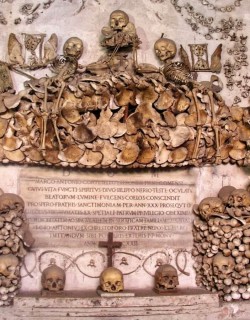
Secrets Beneath Rome: Capuchin Crypt and Catacombs Tour

Domus Aurea Tour (Nero’s Golden House)
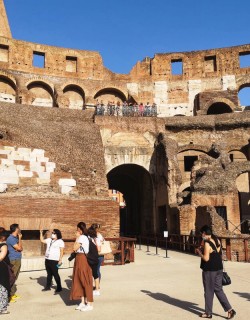
Colosseum with Gladiator Arena Floor, Forum and Palatine Hill Semi-Private Tour

Rome at Twilight Among the Piazzas and Fountains: Evening Semi-Private Walking Tour
Subscribe to our newsletter and receive 5% off your first booking!
You'll also receive fascinating travel tips and insights from our expert team
Subscribe to our free newsletter
Thank you for subscribing!
You should shortly receive a confirmation message with your discount code. If you do not receive this within 5 minutes, please email [email protected].

COMMENTS
Experience Nero's Golden House. Our Domus Aurea Tour explores the original sequence of palaces with gorgeous halls & frescoes.
Tours and tickets for visiting Nero's Golden House in Rome Domus Aurea is the 'Golden House' of Emperor Nero in Rome. After a major fire in 64 AD. Nero built this impressive palace complex, which you can now visit with a tour.
Book tours and tickets to experience Golden House of Nero (Domus Aurea). Reserve a ticket for your trip to Rome today. Free cancellation and payment options - Viator.
Nero's Domus Aurea, Guided Tour in English. An extraordinary experience to explore the sumptuous home built at the behest of Emperor Nero a short way from the Colosseum! This special guided tour is the only way to visit what remains of the Domus Aurea and learn about its history led by an official guide. Duration. about 75 minutes.
The Domus Aurea, or Nero's Golden Palace, is a massive archeological site in Rome, Italy which once had more than 200 rooms. Here is how to take a tour that includes a cool virtual reality experience.
Step back in time to the era of Emperor Nero on this comprehensive tour of the Domus Aurea. Take a walk through the chambers of the building and learn about the architecture and frescoes through your guide's commentary. Cap off your experience with the use of augmented reality tools so you can see what the building looked like centuries ago.
The Domus Aurea is a must-see when you visit Rome - don't miss this special archeological visit of Emperor Nero's Golden House right next to the Colosseum!
Domus Aurea Guided Tour: The Golden House of Nero By Through Eternity Tours 89 reviews 63 About from $101.43 $86.21 per adult Lowest price guarantee Ages 1-100, max of 22 per group Duration: 2h Start time: Check availability Mobile ticket Live guide: English More What's included What to expect Departure and return Accessibility Additional ...
Nero's Golden House (Domus Aurea) tour provides visual insights into how Emperor Nero's golden palace looked 2,000 years ago. The final result will be a true time travel , a sort of cognitive and emotional short circuit, something really innovative in the new technologies applied to the cultural heritage.
Explore the luxurious history of Nero's Golden House, Domus Aurea, on our guided walking tour. Discover ancient frescos, marble walls, and legendary tales of extravagance. Immerse yourself in Rome's awe-inspiring past. Book now and step into a house 'worthy of a man' according to Nero himself!
Our most recommended Domus Aurea Tours. 1. Rome: Domus Aurea Guided Group Tour. Take advantage of a unique opportunity to explore one of the most exclusive ancient sites in Rome throughout a special guided visit to the opulent Golden House of Nero. Experience the magnificent architecture of the notorious emperor's vast palace, which was a ...
The only way to visit Domus Aurea is with a guided tour. Since the Domus Aurea is an underground site with constant restoration works going on, you cannot visit it on your own. The importance and fragility of the site are additional reasons to only allow visitors access if they are accompanied by a tour guide.
Nero's extensive palace grounds - known as the Domus Aurea, Rome - were a mind-boggle. Get the full scope of Domus Aurea paintings, floor plan & more here!
Visiting Nero's Golden House: What To Expect. Nero's Golden House, commonly called Domus Aurea, is a huge palace complex in Rome that was built in 64 AD. The building was never completed, but when it was in its prime it had hundreds of rooms and was fit for an Emperor. While it has been destroyed and rebuilt over time, visitors can still tour ...
Explore Rome's ancient sites on a half-day, small-group tour of Domus Aurea, or Nero's 'Golden House,' the Colosseum, and the Roman Forum. Step into buried history with archeologist guides and use 3D glasses to see Nero's palace as it once was, then hear stories about Rome's golden age as you walk through the heart of the ancient Roman Republic and Empire. This small-group tour ...
The Domus Aurea ("Golden House" in Latin), was the most opulent palace in Ancient Rome. Nero had extravagant tastes, and he took advantage of the fire of 64 AD, which had destroyed many buildings in the centre of Rome, to construct his personal palace. You would expect the palace of an emperor to be luxurious, but even by the standards of ...
🌍 map of Nefteyugansk (Russia / Khanty-Mansiyskiy Avtonomnyy Okrug - Yugra), satellite view. Real streets and buildings location with labels, ruler, places sharing, search, locating, routing and weather forecast.
Khanty-Mansi Autonomous Okrug — Yugra[ a], commonly shortened to Khantia-Mansia, is a federal subject of Russia (an autonomous okrug of Tyumen Oblast ). It has a population of 1,532,243 as of the 2010 Census. [ 4] Its administrative center is located at Khanty-Mansiysk .
The geographical position. Nefteyugansk is located in the South-Eastern part of the Khanty-Mansiysk Autonomous Okrug - Ugra, the geographical location which is related to the Central part of the West Siberian plain. The third largest (after the Surgut and Nizhnevartovsk) Autonomous districts. Nefteyugansk is situated on the right Bank of ...
Khanty-Mansiysk (Russian: Ха́нты-Манси́йск, romanized:Khánty-Mansíysk, lit. Khanty-Mansi Town; Khanty: Ёмвоҷ, Jomvoćś; Mansi: Абга, Abga) is a city in west-central Russia. Technically, it is situated on the eastern bank of the Irtysh River, 15 kilometers (9.3 mi) from its confluence with the Ob, in the oil-rich region of Western Siberia. Though it is an independent ...